|
|
Post by codystarbuck on Aug 8, 2021 12:52:02 GMT -5
The decline in the art is a reflection of upheaval in Grell's personal life. He went through a divorce in that period and has said it was reflected in his work and he is not proud of it. With Warlord, he did it a long time and just ran out of steam to do something new with it. Wife Sharon had been ghost writing, at times and then was doing it regularly. He also was developing Starslayer, for DC when the Implosion knocked it off the slate and he bought it back, leading to the Pacific Comics deal. I loved Grell's art from my first encounter, which I believe was a Green Lantern story, in the back of a Flash comic (GL meets Aaron Burr!), plus a Green Arrow story in Action Comics (can't recall which I saw first, but they were from around the same time frame). I enjoyed the Neal Adams style that was prevalent at DC, with guys like Grell, Irv Novick and Dick Dillin. Warlord was where he really came alive, with his own style, though I only got to see a few pieces of it, until I got to college and picked up the full 50 issue run of Grell, as writer & artist. Grell was the artist I always wanted to meet, because he worked so many things I loved into his work, whether it was homages to Spartacus and Ben Hur in Warlord, or his Merlin, in Starslayer, or the mixture of Mike Hammer and James Bond, in Jon Sable. His work had a sense of humor, a sense of power and a sense of beauty. I finally got to meet him in the early 00s, when he appeared at a small conventio, in Collinsville, IL (near the Mississippi River, close to St Louis). He appeared there, along with editor Mike Gold and John Ostrander, as well as Norm Breyfogle and Kurt Busiek and actress Yvonne Craig. I spent the bulk of my time talking to Grell, Gold and Ostrander about First and DC and their work. I was finally able to ask Grell about the delays in his James Bond project at Eclipse (their money problems meant they couldn't pay to get the book printed), the Brandywine artists (Wyeth, Pyle and Parrish) who influenced his work, his movie homages in Sable and Warlord and other things. The one question I forgot to ask still plagues me to this day: what the hell is that pepperbox hand cannon that Grell gave to Sable when Maggie the Cat returns? I have looked through firearms reference books, gun magazines and scoured the internet and cannot locate a single image that matches the details he drew. he only identified the caliber as .375 H & H. Nothing else. I can find some pepperboxes from the 1800s, with a similar style to the cylinder/barrels; but, not the other details. I have found references to the jet pack he drew in the Berlin story; but, that is the one thing in this series that I cannot identify and it gnaws at me. He drew it with too much detail to have cobbled it out of thin air; plus, he usually used real technology or prototypes that were in development (the jet pack), from Popular Science or similar source. Grell was the only artist who I collected their work, for the sheer sake of the artwork. Before I was done collecting, I had everything, from his first Aquaman back-up story, to his Deadman (in the pages of Phantom Stranger), GL/GA, Legion, Warlord, Batman, Green Arrow, Starslayer, Jon Sable, Shaman's Tears, Maggie the Cat, Bar Sinister, James Bond and even the Donning/Starblaze edition of Howard Pyle's The Merry Adventures of Robin Hood, with Grell illustrations (and the Mike Kaluta one illustrating Thea Von Harbou's Metropolis novel). I had a lot of Byrne and Perez, but not everything. I had all of Grell's work, including the cover to Southern Squadron, an Australian comic that Malibu reprinted. He's a pretty funny guy, who also happens to know his firearms, archery and classic adventure stories and movies. He's also a lot shorter than you expect.  |
|
|
|
Post by foxley on Aug 8, 2021 13:11:32 GMT -5
He's a pretty funny guy, who also happens to know his firearms, archery and classic adventure stories and movies. He's also a lot shorter than you expect.  I've been lucky enough to meet Mike a couple of when he has come out to Australia for conventions (and have a couple of original sketches by him) and definitely agree with this assessment.
Assuming he ever comes back (still no indication of when Australia's are likely to be open again), there is a question I really want him about Sable. I'll raise it here when you reach the appropriate issue.
|
|
|
|
Post by codystarbuck on Aug 10, 2021 23:24:10 GMT -5
Jon Sable #4 I think Mick Dundee would agree, "That's a knife!" Indicia Gag: Close Cover Before Striking! Creative Team: Mike Grell-story & art, Peter Iro-letters, Janice Cohen-colors, Mike Gold-editor Synopsis: It's late in the evening. Myke Blackmon calls Eden Kendall and asks if Jon's manuscript is true and Eden says a friend looked into it and every word appeared to be true... 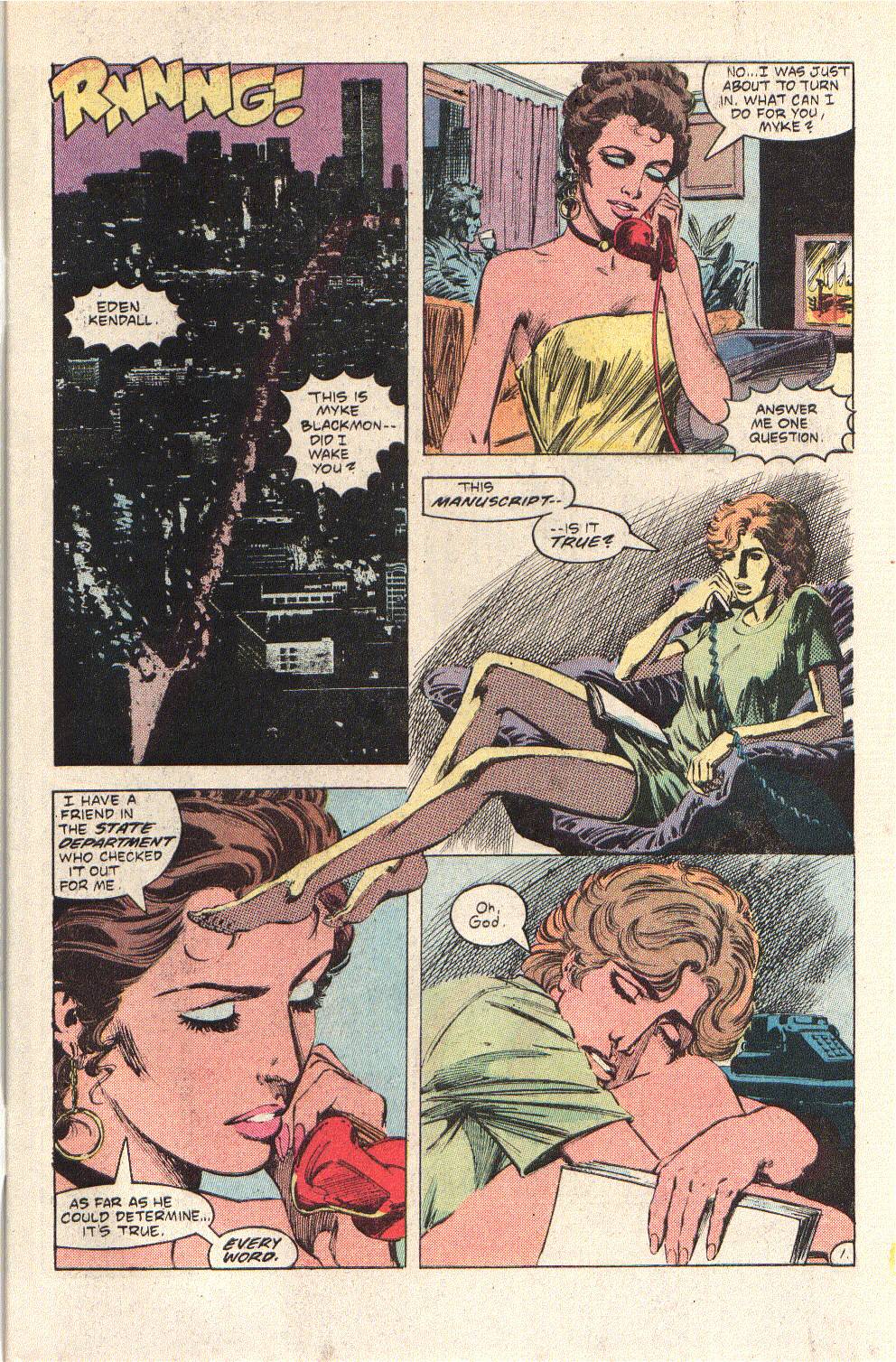 Myke continues reading "A Storm Over Eden," from where she left off, as Jon had come back from culling buffalo to find his family slaughtered by poachers, as a warning.... 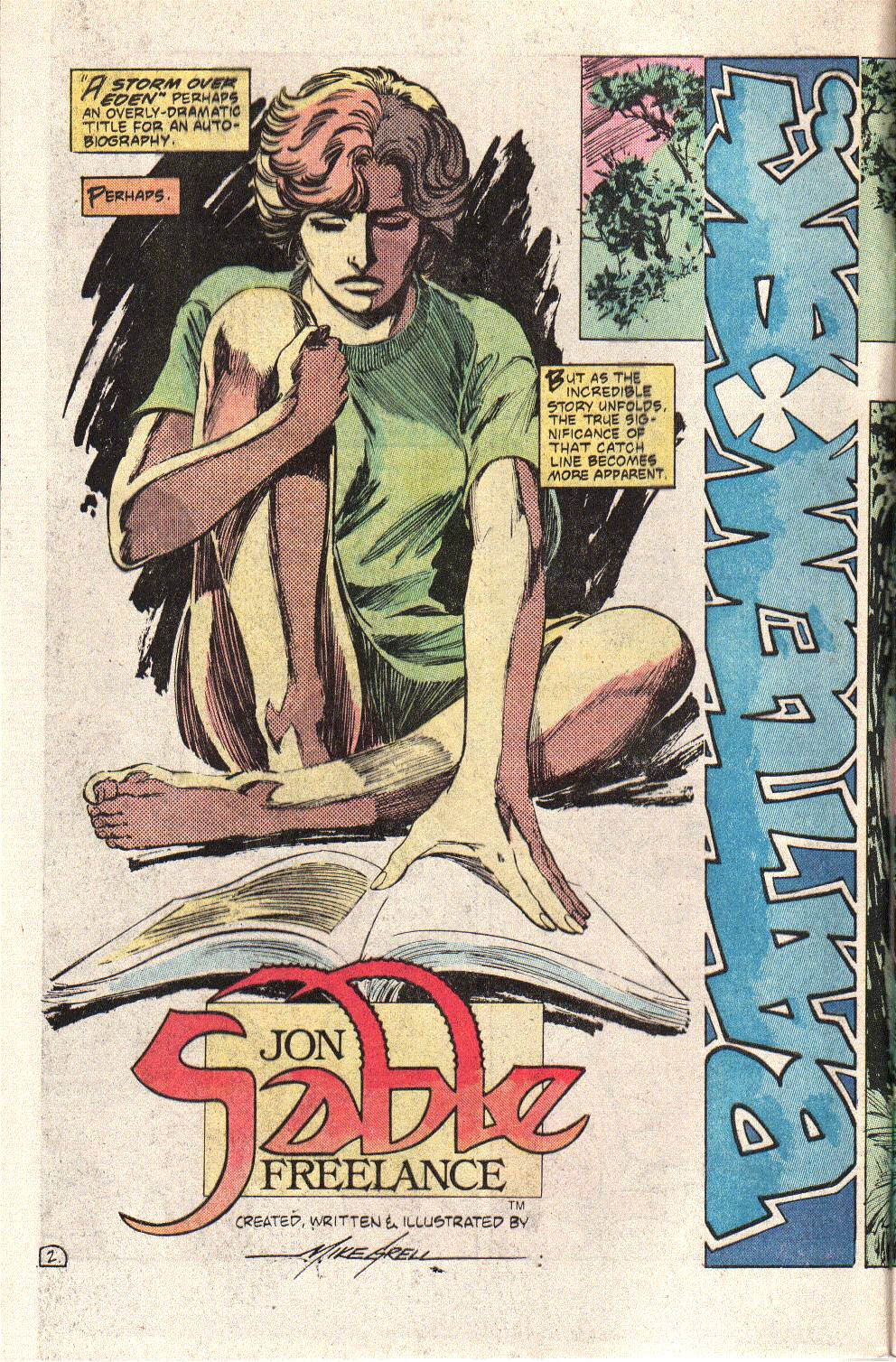 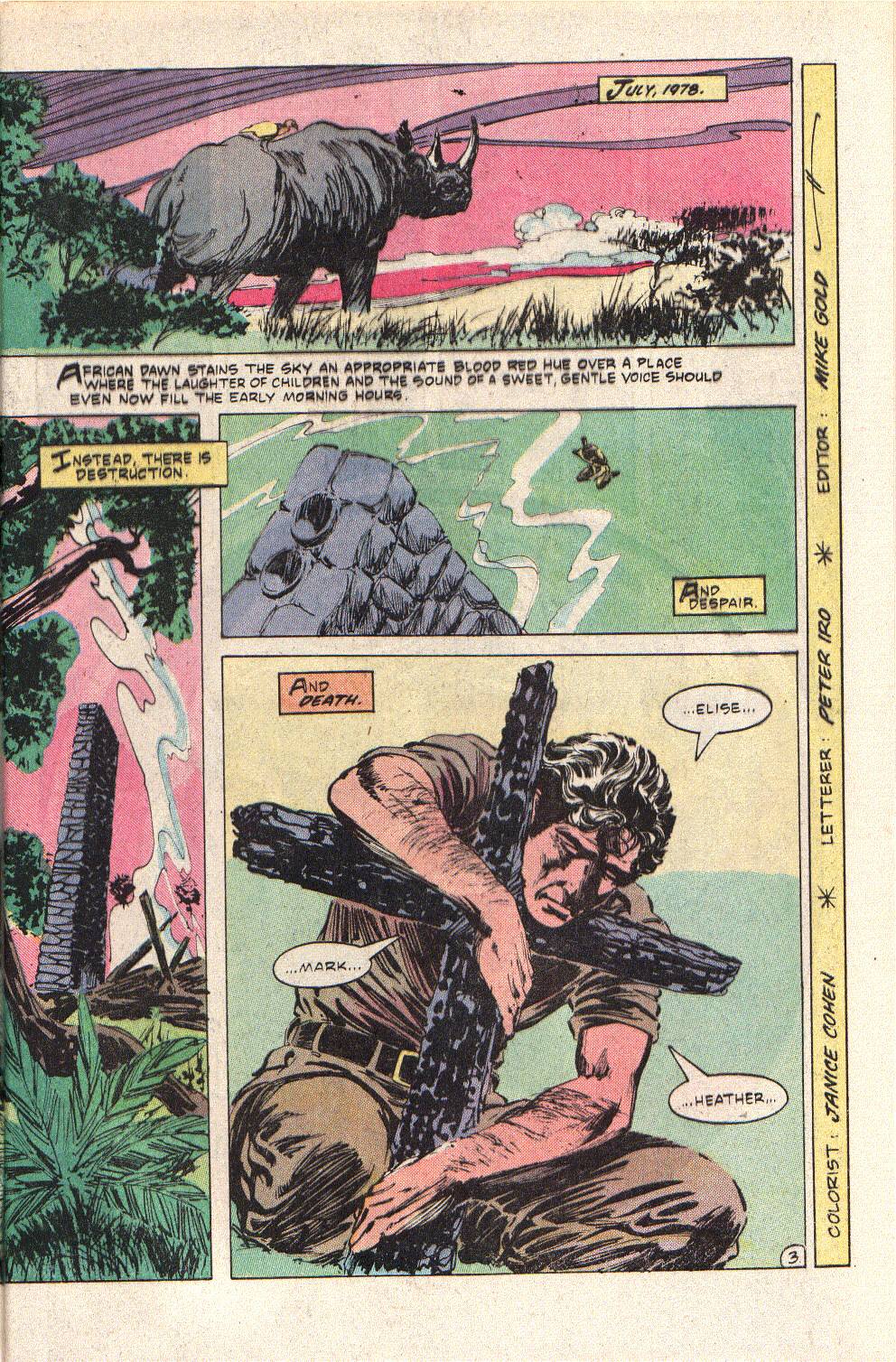 Jon has buried the remains of his family and placed a cross, made of charred wood over their graves. His hands are covered in the ashes of their past life. He grieves until he is empty, then his thoughts turn to rage. He smears the ashes of the past across his face, creating a mask of anger and retribution. Jon is a hunter. He studies the spoor of his prey. He looks at the shell casings on the ground; so many of them. he finds a few unique ones: .41 Magnum. A pistol (revolver, to be exact). You don't see many of those around. That makes it readily identifiable. Prints indicate 8 men in the group, 4 likely natives, in cheap jungle boots and sandals, 3 in vibram-soled combat boots, probably Europeans (whites) and a leader in riding boots, with a pistol. Jon loads his rifle and grabs the bandolier of spare ammo and goes into the bush. 5 miles away, Jon finds where they camped. He finds blood; one of them is wounded. He then finds tracks from a land rover. The leader and the wounded man were picked up. The rest are headed across the Zambezi river. Sable heads for them. He runs and jogs across the bush, heading for the one spot where they can cross, without crocodiles. Hell is visited upon the wicked.... 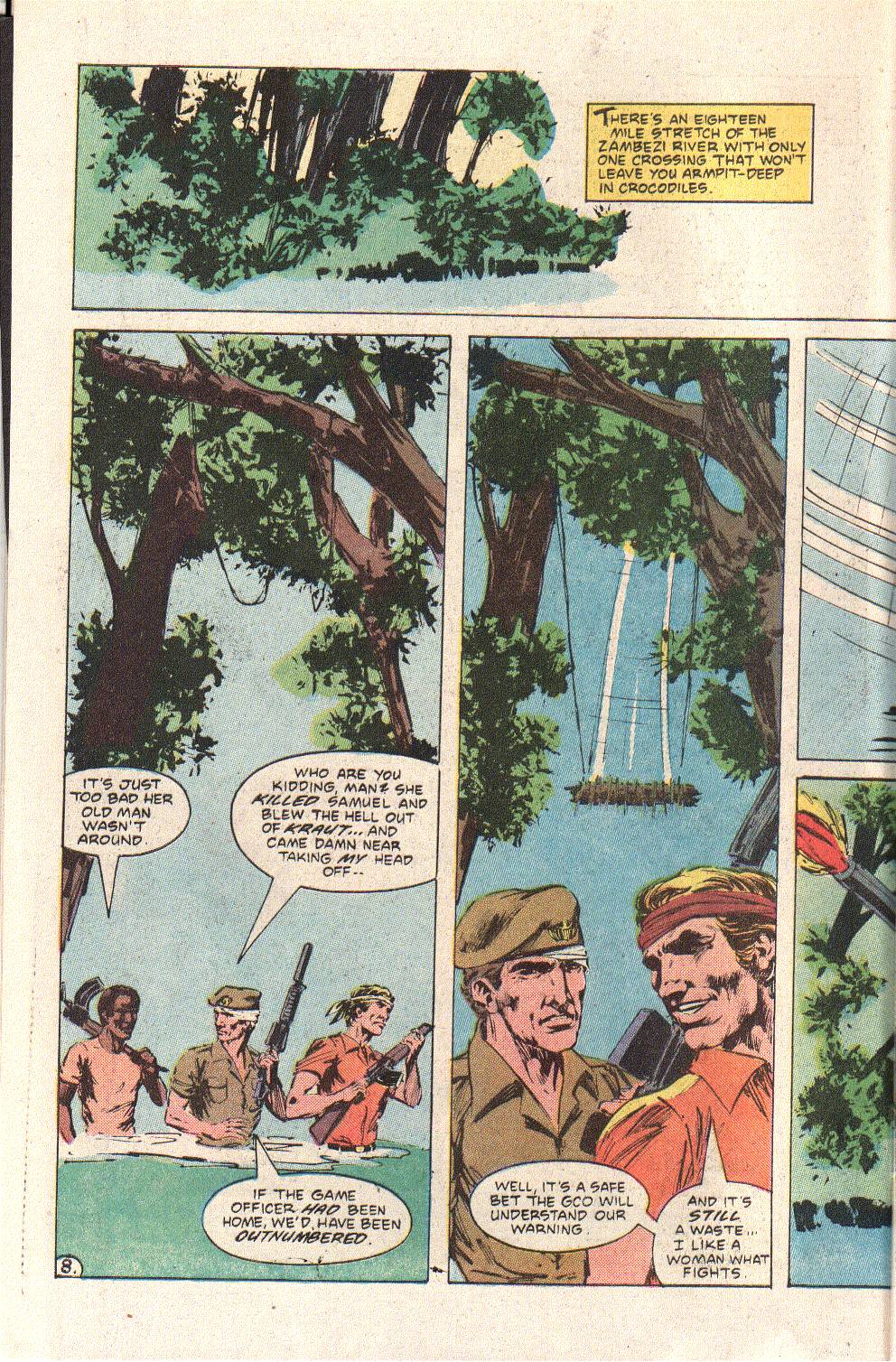 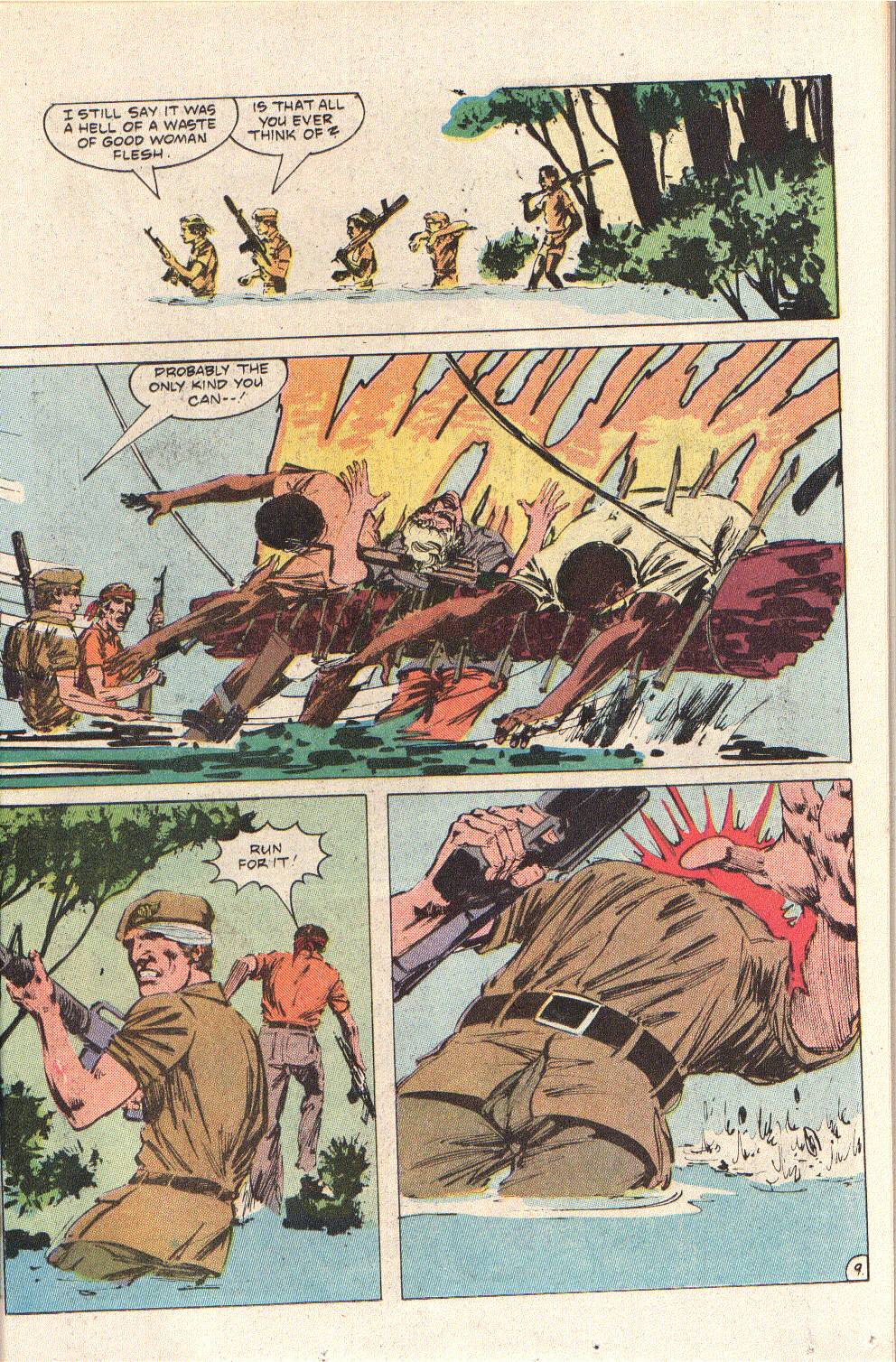 One of the Europeans survives the booby trap and takes off across the bush. He stumbles and falls and gets up and turns, watching for pursuit. Sable has outflanked him and slams his head back against a tree. The man comes to and finds himself in agonizing pain. Sable has impaled his hands with a bush knife, crucifying him to a tree, off the ground. He is above a colony of soldier ants and Sable tells him he wants names, while telling him what ants do to dead animals. the man gives up the name Kraut, a Kikuyu tribesman, but he doesn't know the European leader's name. Sable leaves him and tells him, if he tries hard enough, he can die, before the ants get to him. he leaves the man screaming, "Who are you? Why?!?" Time passes. Poaching in the area between Rhodesia, Botswana and Zambia continues, but soon the poachers find that something is hunting them. Rumors begin to swirl about elephant spirits wreaking vengeance on poachers, as they are burnt up in oil slicks that flow into rivers and wake up in encampments to find comrades impaled by elephant tusks. In fact, it is the ghost of a man, living rough in the bush, endlessly seeking someone who knows the name of the white-haired man. He leaves behind reminders for others to find that indicate a brutality beyond comprehension. Finally, in December, Hal, the Game Warden, comes to Salisbury, the capital of Rhodesia and goes into a black nightclub, looking for Jacob Inyati. He finds him and despite Jacob's banter about Rhodesia's apartheid policies, he says he needs his help to find Jon. Jacob remarks that Sable is a friend, a rare thing in a country torn apart by exploitation and racial strife. Jon treated him with dignity and respect and they shared laughs over the racist fools they took out on safari. Hal says he needs his help to find Jon and bring him out of the bush. Jacob tells him he saw the house and isn't sure he wants to find Jon. Still, Jacob cares about the man and agrees. The next morning, he goes to the site of the house and begins tracking Jon. Jon finds Jacob first and attacks him from behind, holding a knife to his throat, asking if he knows the name of the white-haired man. Jacob yells at his friend to recognize him and Jon recovers his sanity. He asks how Jacob found him and he remarks that he has crossed the site of the house so much he has practically created a trail. Jacob tries to reason with him, to get him to come out of the bush. He has been hunting for 6 months. Jon won't leave; he is close to finding Kraut, the Kikuyu. He wears a German wehrmacht field cap that his father took off of one of Rommel's troops. Jacob says he will die out there and Sable laughs and says that's the general idea. He leaves Jacob. We cut to another location, as the white-haired man is on horseback, target shooting, while he tells Kraut that someone is cutting heavily into the ivory trade and they are going to hunt him, with some ivory bait. 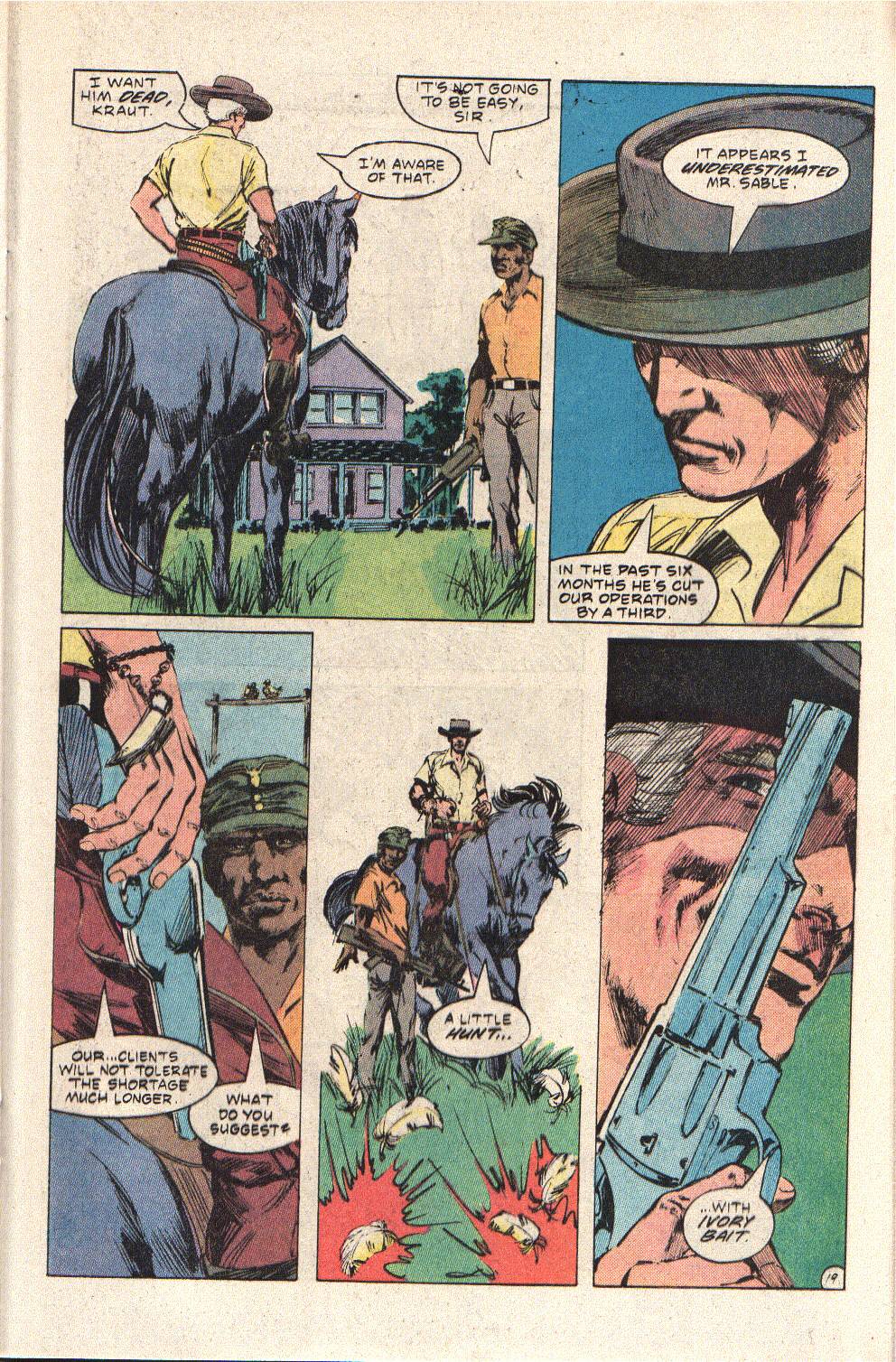 He sends a column of bearers, loaded with ivory tusks, through Jon's hunting area, with armed scouts as flankers, hoping to draw Jon out and kill him in a crossfire. Sable waits, patiently, in the bush. As the column marches down the trail, Sable picks his moment, as the column is perfectly lined up and he fires his rifle through all 5 men. The flankers open fire on him with AK-47s. Sable kills one with his remaining barrel and then Kraut rushes at him. Sable quickly reloads and shoots Kraut in the chest, but his AK blocked the shot. Kraut is knocked down by the kinetic energy but the bullet doesn't penetrate his rifle's receiver. Another flanker fires on him and Jon maneuvers and shoots the man through a tree. Jon ejects his spent cartridges and Kraut attacks with a bush knife and Jon barely gets his rifle barrel up to block, in time. He then hits Kraut in the face with the butt of the stock and then straddles him with his hunting knife, wanting the name of the leader. Kraut starts to give it and is shot dead by the white-haired man. He also wounds Jon and goes after him. Jon slips away, but is weakening and leaving a blood trail. He moves to the river and finds himself trapped on a ridge, over some waterfalls. The man corners him and then says that Sable's wife put up more of a fight. Sable's rage explodes... 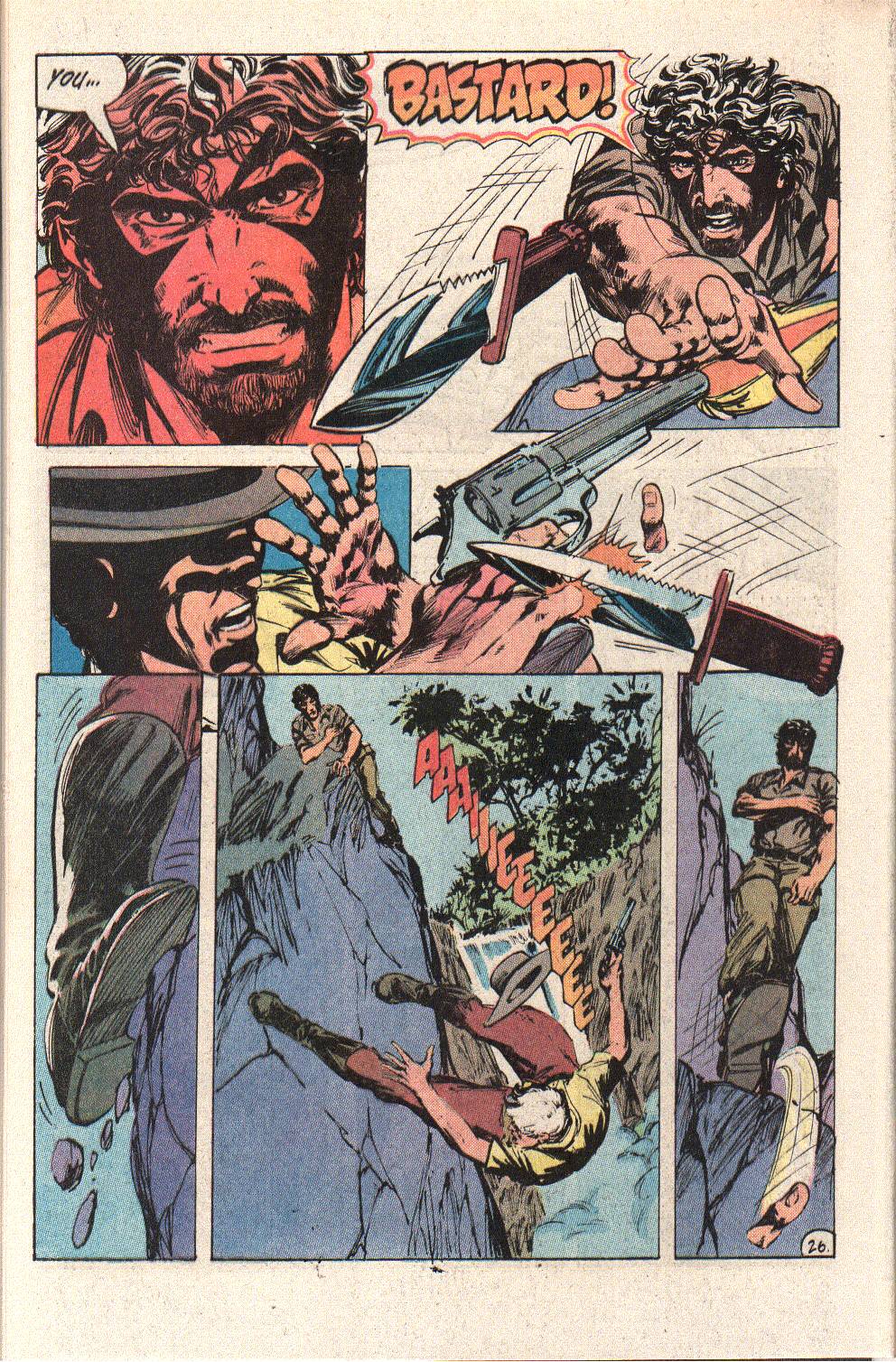 His knife cuts through the man's pinky, severing it at the joint and he loses his footing and goes into the river. Now, in the present, the man holds his .41 Magnum, with 4 complete and one partial finger and a lion's tooth necklace dangles from his wrist. He is in Salisbury and tells his men that Sable is coming. In the bsh, Hal tries to reason with Sable, as he loads a stripper clip into his Mauser and then traces his battlemask across his face. He says they won't stop him, this time and goes off hunting. Thoughts: If last issue was tough, this one is total horror, as Jon descends into a killing madness. Basically, he's looking to die, but he hopes to take the men who destroyed his life with him. The man who was Jon Sable died when he entered the remains of his house and saw the bodies of his family. What remained became a ghost, endlessly hunting for the white-haired man, and nearly dying for it. His friends try to bring them out, but even they recognize he is too far gone and wonder if it isn't best to let him die out in the bush, as his soul has already died. The beginning shows how much Myke has become invested in this story and how scared it has made her. She has feeling for Jon, but is wary of the dark side of him and now she knows she is right to be wary. Grell moves beyond the normal pattern for men's adventure pulp fiction. Most of the heroes were born in tragedy and seek vengeance, but that is about all there is to te characters. rarely did the author's spend time detailing their relationships to lost loved ones. That was cursory backstory of the righteous avengers, unloading hot lead upon the criminal scum. They are real men, heroes of the age of John Wayne, bringing justice to the slime that liberal society lets run the streets while blathering about "their rights." Grell isn't that simplistic. He gives us a reason to care about Sable's loss, as we see his family grow and how happy he and they were. Then, they are taken in violence and we see that warm, sensitive, funny man fall to the ground and cry out in anguish. The man who stands back up is a cold-blooded killer, wreaking his vengeance, but killing himself a bit each time. The more brutal he becomes, the more he loses pieces of himself. There is no glory in his killing, only death and madness. He's also not superhuman, as he is wearing down, making mistakes. He leaves trails for Jacob to follow and walks right into a trap, from the white-haired man. It nearly costs him his life. Sable isn't out to bring justice, but to die, yet he can't quite bring himself to give in. Something inside him tells him that he must go on. He buries it deeply, but it still surfaces and he fights to stay alive. He rationalizes it as vengeance, staying alive to kill the white-haired man; but, there is more to it. Grell also continues to show the adult nature of the book. Not in the scenes of violence, but in the opening page, when Myke calls Eden. She says she hoped she didn't wake Eden, as it is late. Eden says she was about to turn in and we see a fire going and a man sitting on her sofa, drinking wine. Eden is all dolled up and we can fill in the blanks. It cements the idea that she and Sable are not a romantic item; just casual lovers and business partners. They turn to each other when they need it, but they have other relationships. Nothing more is said or shown, as Grell lets us draw our own conclusions. Grell also makes comment about the political situation in Rhodesia, at the time of the story. Rhodesia was a nation with great mineral wealth and rich land; and, it was controlled by a white minority, through its own system of apartheid. Blacks were denied voting rights and pretty much all rights, including owning the land. The anger and resentment built into a civil war, though the two rebel factions spent as much time killing each other as targeting the white government and society. Still, they were determined and outside pressure was wearing down white resistance. We see it mentioned, as the white man, Hal, enters the racially segregated club, where Jacob is relaxing with friends. This is a major taboo, yet Jacob respects Hal and considers Jon a true friend. Jon helped Jacob laugh at the stupidity of the white minority which is a powerful tool, in a resistance movement. When you can laugh at your oppressor, you take away his power over you and see him for what he is. That shows that he is vulnerable and can be defeated, because his position is absurd and cannot stand, in the long run. Trevor Noah, in speaking of his own family, in South Africa, remarked how his grandfather taught him the power of humor, by the way he would joke with white police men. Grell gets violent with his scenes of Sable's vengeance and his war of terror on poachers. Batman is a Quaker, by comparison. However, he pushes a bit beyond what the Code would allow, since First didn't submit to the Comics Code; and, yet, he never makes it too gratuitous (maybe a little, in a few panels). He gives you just enough to let your mind do the rest. There are some artists out there, who would have had entrails hanging out of people and blood spurting like a burst pipe (and some filmmakers, too); but, Grell knows when to let it have impact and when to suggest more than show. Regardless, he never makes it cool. It is horrifying and it represents the madness within Jon. It is not depicted as righteous; more self-destructive. Grell knows that violence is part of the drama for an adventure series, but he never presents it as something cool, with slow motion tracking shots and ballets of blazing guns and spurting blood. There are no quips to punctuate things. If there is one element that doesn't quite work, it is the battlemask. No matter how I picture the ritual of Sable dragging his hands across his face, smearing it with the ashes of his family and home, there is no scenario where I can realistically envision his actions creating that design. The tv version, with more of a camouflage pattern, made more logical sense. The comic book version is just that; a little too "comic book." It seems to be a concession to the superhero crowd, to get them to try the book. It lets them rationalize picking up the book, "Well he wears a mask and hunts criminals; so, he is a sort of superhero." If the ashes just streaked down from Sables eyes and forehead, I could buy it; but, it frames his face too deliberately. Still, this issue answers why he wears it, at all. It is his face when he goes hunting man. It "scares the hell out of the bad guys," not because of the design, but because of his own face, framed within. That is an animal killing machine and it is terrifying to look at. Without it, the real Jon Sable appears. The character of Kraut is supposed to be a Kikuyu, which is a tribe of Bantu origin, who live in Kenya (and parts of Tanzania), particularly around Mount Kenya. They are the largest ethnic group in the country and the first president of independent Kenya, Jomo Kenyatta, was of the Kikuyu people. Kenya was a British colony, in WW2 (as was Rhodesia) and it is likely that Kraut's father was part of a colonial regiment in service with the British forces in North Africa, allowing him to take the field cap off a dead panzer grenadier. Next time, Jon gets drawn into the Rhodesian Civil War and finds that he isn't necessarily on the side of angels.
|
|
|
|
Post by foxley on Aug 11, 2021 4:33:58 GMT -5
Another excellent summary of another powerful issue codystarbuck. For some reason, that 'reading the spoor' scene has always stayed me and is one of my central images of images of Sable. |
|
|
|
Post by codystarbuck on Aug 11, 2021 11:21:44 GMT -5
Another excellent summary of another powerful issue codystarbuck . For some reason, that 'reading the spoor' scene has always stayed me and is one of my central images of images of Sable. It's one of the elements I like about the series, and Grell's work. It's attention to detail. Using the Batman example, far too many writers and artists have him stumble into clues and there is little examination, other than magic computer analysis. others actually have him study things. Grell is of the latter variety, as his heroes use their brains as much as their brawn. It's part of why I always liked his writing, especially in the 90s. He seemed an odd duck, at Image, with their mindless violence and generic superhero clashes, repeated endlessly. His characters were more complex and used their heads and hands. Of course, the market didn't give a s@#$; but, then again, I thought Shaman's Tears was kind of a lesser work from Grell, with too much deliberate pandering to the Image audience. It especially filtered over to the two issues of Maggie the Cat he did there, as her sensible work clothes got turned into a corset and stilletto-heeled boots. Just the thing for scaling walls and slipping past security sensors! At least she had realistic proportions, which put her ahead of every other female at Image. |
|
|
|
Post by codystarbuck on Aug 14, 2021 21:49:59 GMT -5
Jon Sable #5 Given that Jon never uses an Uzi in the story inside, I have to wonder if that cover scene wasn't inspired by the movie The Wild Geese. Indicia Gag: Close Cover Before Striking. Time for a new one, Mike! (Gold, that is...) Creative Team: Mike Grell-story & art, Peter Iro-letters, Janice Cohen-colors, Mike Gold-editor Synopsis: In the present, Jon comes to a favorite spot from the past and relives visions of his beautiful wife playing with their kids, in the unspoiled beauty of an African stream. Jon sees Elise's face in the water and tries to touch it and it disappears. He then checks his Mauser and inserts a magazine (after top loading it, in the previous issue). The hunter has come back to his hunting grounds. Meanwhile, in New York, Myke looks out at a rainy, gloomy day and sees that the atmosphere is perfect and continues reading Jon's manuscript...  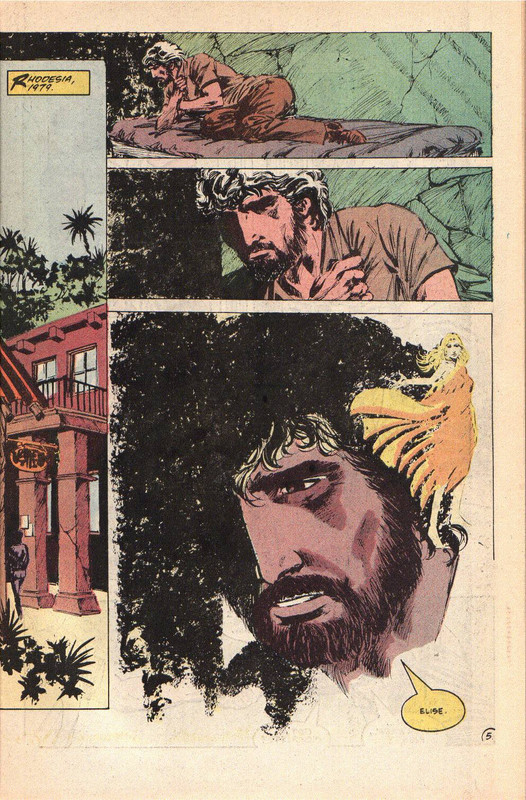 In Rhodesia, 1979, Jon has come out of the bush, but it hasn't left him behind. He is a mess, sleeping off a bender, in the local jail (or gaol, to use the likely local spelling). He is awakened by a guard, who tells him he has a visitor and he is reacquainted with of former fellow Olympian....  ...Milo Jackson. Sable asks what he is doing there and he said he was making good money putting his Vietnam experience to good use, in Rhodesia's civil war. Sable corrects him, why is he in the jail, bugging him. Jackson tells him that he needs him for a job. A group of balloonists went down in a storm, in Chizarira National Park, which is a major guerilla zone. One of the kids is a senator's son and his parents are eager to get him out, safe and sound and the Rhodesian government wants them found, before there is an "incident." They came down near a ranger fort and are holed up there. Jackson is taking a patrol into the bush to bring them out. Sable knows the area well. Jon tells him to look elsewhere and Jackson offers him $10 Grand for 2 days work. Sable says he doesn't care about Jackson's war and he says nether does he. Jackson is in it for the money. He is a danger-seeker and doesn't care about politics, Cold War or racial. He lives it up, because a man can die out there. Hearing that, Jon says he has convinced him and signs on. He stands up, unsteady and Milo asks if he is okay. Jon says he just needs a drink and Milo slams him against the wall and tells him, "No Booze!" He is dry until the mission is accomplished, then he can drink himself stupid. Jon gets cleaned up and kitted out and joins Milo, who introduces him to the rest of the team...  They are all captains, except the black man, Sgt Tate. He says not to worry, he will be a colonel when majority rule comes and he still gets equal shares. Jon is not a fan of the red beret, which marks him as a mercenary, which isn't likely to help him, if captured. They take a land rover and a deuce and a half (truck) into the bush. Jon tells Milo they can save time if they cut across an area of marshland, which he says is bone dry, at this time of year. They cut across, but soon find they have company, as a Supermarine Spitfire fighter plane strafes them.  They return fire with their rifles, to little effect. Jon stand up and fires to draw in the aircraft, then falls onto his back and continues firing as it passes overhead, shooting the underbelly and knocking the plane out of the air. They regroup and one of the team is dead. The land rover's engine is shot up and useless and the Spitfire destroyed the truck. They are on foot and figured that the pilot radioed in and they will soon have guerilla company, on the ground. They get moving, after figuring their shares just went up. Hours later, they come upon the ranger fort, which used to be their HQ; but, with the bush war going on, they fortified the place to hold out until the fighting is over. It is essentially a large bunker, dug into the ground and reinforced with timber, with sloping corrugated tin sides to deflect munitions away from it and sandbags covering the roof. There are observation ports and gunholes on all four sides. The team then spots a group of guerillas attacking, with their distinctive AK-47s firing. They make a run for the fort. Two more men go down and the rest make it and hunker down inside, as the rangers give covering fire. The team is down to Jon, Milo and Sgt Tate. The guerillas pull back, but the ranger says they will stop, once they are out of rifle range. Milo gets them a few more yards, sniping with his FN rifle. The ranger recognizes Sable and says he thought he was dead. he introduces the trio to the balloonists: Ray Arnold, Cynthia Bishop and the senator's son, Stephen Lauter. Lauter tries to play important but Milo shoves him into a chair and tells him to be quiet, while the adults talk. Milo and Jon confer and neither has a good plan to get out. the ranger says their radio took a ricochet and is kaput, so no back-up. he intends to use an escape tunnel to take his men into the bush and wait out the assault. Sable figures the civilians will get them killed, in the bush, then hits upon an idea. He asks about the balloon equipment. It's near, but it can't hold 6 people and would take too long to inflate. Milo is about to offer to go alone, but the others nix that idea, with their shares now standing at $20 grand a piece. Sable has an idea. The civilians work on preparing the balloon to inflate, while Tate gathers petrol, in jerry cans. Sable creates a fire line between them and the guerillas, while they inflate the balloon. The fire spreads through the dry brush quickly and drives the guerillas back. Sable cuts the gondola loose and they fashion "Swiss seats" to suspend themselves from the guide lines. the balloon has enough lift to carry the 6 people; however,t he winds blow it over towards the guerillas. sable orders everyone to dump everything, guns, cameras, boots...any weight they can. they still aren't gaining enough altitude and Sable notes Cynthia still as a bag slung over her shoulder and tells her to dump it. She refuses and then proceeds to tell them that she is the real reason they were hired...  She is a courier for an ivory smuggling cartel and is bringing a big payoff across the border, secretly. She offers double their salary to get her to Salisbury, alive. Sable says it doesn't matter if the guerillas shoot them like ducks. They need to gain altitude and lighten the load. Ray snarks about which one she plans to kill. She tells him they need him to land the balloon and the mercs wouldn't leave the senator's kid, in case the money is actually coming from daddy. She then pulls out a pistol and says to shoot Tate, only she refers to him with an Arabic word that means "unbeliever", but which grew to become a racial slur, in South Africa, (starts with a K, rhymes with "zephyr" and has the same connotation as the N-word). Sable kicks her gun hand aside and she misses, then she twists to get a shot at him. He grabs the bag to gain control of her and she shoots him in the shoulder. Their lines become twisted around and Milo cuts through one of them. Cynthia drops, but hangs onto the bag. It tears apart, from her weight and she plunges to the ground below. A white powder cascades out of the bag, following her down. They land at a village and Milo sends a runner to alert the authorities and bring in an evac chopper. Jon's shoulder is bandaged up and Milo asks what was in the bag.  Jon asks him how he knew which rope to cut and Milo walks away, without answering. Back in the present, a group of men wait in ambush positions, around the remains of Jon's former ranch house. He spots them, from a tree and readies himself. On the letters page, a reader questions a sitting president contracting an outsider to stop an assassin and Mike Gold reminds him of the Watergate burglars, who were hired by Nixon's team, from outside. He also suggests that Reagan would be just the man to do something similar. This is 1983. 3 years late, journalists uncovered a secret operation by Reagan's National security team to illegally sell arms to Iran, despite an official embargo, and then funnel the proceeds to the Contras, in Nicaragua, using primarily outside contractors (read "mercenaries") to carry out the operation, one of whom was captured by Nicaraguan government forces, while ferrying arms to the Contras. Next time you see him, ask Mike his picks for the lottery numbers; he has a gift of seeing the future! Thoughts: This issue is action packed, but lacks the emotional impact of the previous 2 issues. There is still a bit there, as we see Jon grasp at ghosts, at a favorite spot and in Myke's body language, as she looks out on a gloomy day and returns to the manuscript. After that, the emotional level is at a minimum, replaced by adrenaline and anxiety. Because of the first issue, we know that Milop betrayed another team into guerilla hands, for money and would have included Jon, had he not been wounded in this mission and had to stay at base. Jon went hunting for him, but Milo wisely left Rhodesia for another war and a payoff. Eventually, Jon got his payback. A lot of the plot reminds me of two similar movies, about mercenaries in Africa, based on novels (well, manuscript, in one case): Dark of the Sun and The Wild Geese. Dark of the Sun was a novel by Wilbur Smith, in 1965. It features a group of mercenaries, in the Congo, who are dispatched on a train, into enemy-held country, to bring out Europeans from a diamond mining operation. The real target is a load of diamonds, rather than the people. It was adapted into a film, in 1968, with a few changes. the novel was set earlier in the period following the independence of The Congo from Belgium, during the time when Katanga had seceded from the nation, with the backing of Belgian mining companies (and the tacit approval of the government) and a large contingent of mercenary soldiers (the bulk of whom were on detached service from the French Foreign Legion). The UN provided troops to try to put an end to the civil war, leading to armed conflict between UN troops and the mercenaries and Katanganese soldiers. This included an Irish contingent who held out in an encampment in a place called Jadotville, until they ran out of ammo, while under assault from the mercenary forces, including fighter aircraft, with no relief from UN troops (the Siege of Jadotville). The film moves things to then then current battle between the united Congo (Katanga rejoined the nation) and the Marxist Simbas, led by Christopher Gbenye, who took over the city of Stanleyville and threatened to kill white Europeans there, leading to a rescue operation carried out by the US Air Force, Belgian para-commandos, and the mercenary soldiers of 5 Commando, under Maj. Mike Hoare, an Irishman who had emigrated to South Africa, before coming to the Congo as a mercenary officer. The movie still used the basic plot of the mercenary soldiers taking a fortified train to the mining town to bring out the civilians and the diamonds, but also has them effecting a rescue of their own, from the Simbas. Rod Taylor starred as the mercenary commander, somewhat based on Hoare and a few of his soldiers. Jim Brown plays a Congolese soldier (schooled in the US, to explain his accent) and Peter Carsten is a former German soldier (possibly Waffen SS), based on German mercenary Siegfried Muller, who had served in the Wehrmacht, in WW2. Same basic idea, mercenaries go into hostile territory to bring whites out, but find out that the real target is a commodity of high value. The Wild Geese was based on a manuscript by Daniel Carney, a white Rhodesian who served with the Police Anti-terror Units. It features a group of mercenaries, led by Col. Allen Faulkner (modelled after Hoare and 5 Commando), who are hired to rescue the deposed president of an African state, by a mining concern, who then use the rescue as leverage to negotiate a deal with the current government and betray the mercenaries, to save themselves paying their salary. The mercenaries parachute in to rescue the former president from an Army barracks, before he is executed, and seize an airstrip. however, they are betrayed just as their airplane is arriving to pick them up and they are left on the ground, with the Simbas coming for them. They takke off into the bush to try to get across the border and end up learning about a DC-3 Dakota, which could fly them to safety, in Rhodesia. They fight a running battle in the bush, including a massive assault in the finale, as they secure the aircraft and move it onto the runway, for take off. The plot here borrows from both those stories, with similar beats and scenes, as well as scenarios, but only bits and pieces. You could also point to Frederick Forsyth's The Dogs of War, about mercenaries hired to launch a coup in a West African nation, by a mining company (Carney borrowed a lot of its plot for his book), somewhat inspired by Forsyth's time as a journalist and spokesman, during the Biafran Secession, in Nigeria, in the 1960s. Forsyth came to know several mercenary soldiers during that time and based his characters on those men. he was also alleged to have been involved in an attempted coup in the island of Fernando Poo, aka Equitorial Guinea, which fell apart when Spanish authorities seized an arms shipment. Forsyth has since claimed he only conducted research for his book, while others who investigated the story said he was a go-between for the backers of the coup and mercenaries hired to carry it out. This basically serves to set up Sable's background as a mercenary soldier, in Rhodesia, to illustrate the transition from sportsman, to safari guide and game control officer, to ruthless killer. Here, he kills for money (and survival). It gives him something he lacked while out hunting for the poachers: a thrill as he runs a razor's edge, between life and death. Sable has a death-lust, because of his loss, yet a part of him still wants to live. This feeds both impulses, while giving him some of the thrills of competition and hunting. Grell did his research, as the tactics and weapons are sound, though his depiction of their ammunition and equipment rigs does not match those in use in Rhodesia, based on pictures I had seen, at that time (I got a lot of military-related magazines and reference material, when I was in high school, still buying into the Hollywoood version of the military, before experiencing the professional reality). It's nothing major and only someone who had read up on the subject would notice. He draws the men carrying Belgian FN-FAL battle rifles, which were used by numerous armies in Africa and Europe, including Rhodesia. the guerillas are armed with AK-47s, which was common for insurgents across the globe, as the two main arms brokers in the world were the US and USSR. The Soviets (and Chinese) provided arms for numerous revolutionary groups and friendly governments, just as the US and Great Britain did for friendly nations in Africa, Asia and Latin America. The red berets are not necessarily the mark of a mercenary, as many in the Congo wore green ones, with the French Metro Para badge... 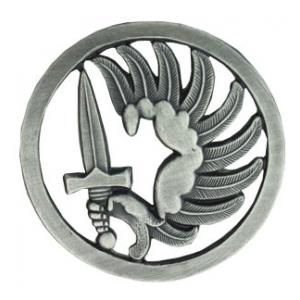 It is likely that the red color was inspired by the Wild Geese, as the lead actors (portraying the officers) all wear red berets, while the mercenary soldiers wear predominantly khaki ones. Grell draws an eagle emblem, but I have never come across a match for it and believe he designed it himself. It has the right feel for a military beret badge, especially a special operations unit. One thing is for sure, Grell is one of the few artists of his generation who could draw a proper military beret (and he was Air Force, though the Air Police wore blue berets). Most tend to draw them either like the Basque/French stereotype, with rounded shape, sitting squarely on the head; or, in the style of a tam-o-shanter of the Scots (minus the little ball on top). Grell understands how sodiers drape a beret, to slant down on one side, in a rakish angle. There is a whole protocol among units who wear them, in many armies. The French wear them draped from right to left (emblem over the right eye and the material slanted towards the left ear) and most other nations from left to right. The US Army evolved a slight variation to this, due to using berets with more material than those in most European armies, with a slight dip, at the front, behind the unit flash (for special units, like Airborne or Rangers) or US Army flash (for regular Army), then draped left to right. Vietnam-era Special forces wore theirs more in the European style. In reality, most Rhodesian units wore bush hats, to help had their faces and shade their eyes from the African sun, much like US troops in Vietnam (at least, Ranger and Special Forces units). The Rhodesian bush hat was similar to the Vietnam-era US Army jungle hat, or what most people know as a "bucket hat" or "fishing hat" (think Henry Blake, on MASH). Spitfires were flown in Rhodesia and South Africa and several WW2-vintage aircraft were flown by smaller nations and groups in the years after the war. The first fighter plane flown by the Israeli Air Force was the Messerschmitt BF-109! At the beginning, we see Sable seat a magazine into his Mauser. Only the selective-fire version, the Schellfeuer, had a detachable box magazine, like modern firearms (or other auto pistols, like the Colt M1911, the Luger P-08, or the Browning .32 ACP). At the end of the previous issue, he is shown loading a stripper clip into a fixed magazine, form the breach, which was the usual fashion for the standard C96 Mauser. It is my understanding that you couldn't do both; so, either Sable used both versions or Grell couldn't keep it straight, or just figured the detachable magazine would look more dynamic. Cynthia says she was a courier, with a payoff for the ivory cartel, in Salisbury. Those are the same people behind the murder of Jon's family. That suggests the white-haired man survived the previous issue (which we knew, from the last page in issue #3). Cocaine or heroin would seem an odd payoff; but, like diamonds, it is easily converted to cash, anywhere in the world and easier to smuggle. It makes sense. To my mind, this is the weakest chapter in the origin story group, though it is still a darn good action story. It just lacks the emotional core of the other parts. Some of that can be put down to Jon being dead inside, in this timeframe. I do think it kind of ignored the reality of the Rhodesian civil war in favor of a more Hollywood-style adventure. It's a bit harder to make Jon sympathetic when he is out hunting black revolutionaries for an apartheid government. Next issue will address that (and kind of sugarcoat it), as Jon moves on with his life. Next issue also captures more of the human element, as Jon tries to rebuild his life in America and finds an unexpected link to his family, as well as fame and fortune. He also finally catches up to the white-haired man and learns who he really is, as "A Storm Over Eden" concludes.
|
|
|
|
Post by codystarbuck on Aug 14, 2021 22:57:01 GMT -5
ps For comparison, here are clips from the two movies cited... (WARNING: NSFW! Language and graphic violence) The black mercenary soldier, Jesse, is played by a young John Kani, who, along with Winston Ntshona (who plays Limbani, the rescued deposed president), was a leading stage actor in South Africa, appearing in two noted anti-apartheid plays. He would (much) later portray King T'Chaka, in Captain America: Civil War and Black Panther. In Dark of the Sun, you can see the betrayal by one of the mercenaries (Peter Carstens), who kills the lead's friend and they clash in a brutal finale (including chainsaws!), much like Milo, as see in issue #1. Wild Geese has the running battle aspect, as well as the specialists being recruited, trained, and operating in the bush. The Wild Geese was filmed in South Africa, with the aid of the South African Defense Forces. Several of the mercenary extras were serving South African soldiers (under the apartheid government). The technical advisor was Maj. mike Hoare, commander of 5 Commando, in the Congo. He was born in India (to Irish parents), served in the British Army, in the Burma theater, during WW2 and emigrated to South Africa, before he came to the Congo, during the earlier Katanga Secession, then came back later, when recruited to fight the Simba rebels. One of the actors, Ian Yule, who plays the character "Tosh," had been a mercenary soldier and served under Hoare, in the Congo. After filming, Hoare was recruited by the South African intelligence services to carry out a coup, in the Seychelles Islands, which lie in the Indian Ocean, in close proximity to South Africa. A Marxist government had seized power, in a bloodless coup, while the corrupt and flamboyant president, was out of the country. South Africa feared that a Marxist government would be sympathetic to anti-apartheid groups and be used to funnels support to them from the Soviet Union and China. Hoare was recruited to raise a mercenary force to infiltrate the island, disguised as tourists (the Seychelles is mainly a tourist destination, for its beaches and ocean fishing and diving) and seize control of the country. The team had weapons hidden in their luggage, but one of the soldiers got into the wrong line at customs and an official ordered him to put his luggage up for search. the official felt the outline of a disassembled AK-47 and called a guard. The mercenaries pulled out their weapons, but they were trapped at the airport, as there were military advisors from Tanzania in the Seychelles, who had armored vehicles and blocked the mercenaries' escape. They hijacked an Air India airliner and forced it to fly to South Africa, though the captain claimed they willingly agreed to carry the mercenaries out and that they did not hijack the plane. The mercenaries who escaped (many were captured in the Seychelles and put on trial), including Hoare, were arrested and tried for hijacking the plane. Hoare served just under 3 years in prison. He died last year, at the age of 100. Similarly, another mercenary officer in the Congo, Bob Denard, was a former French police officer, who was an agent of the French intelligence services. he served as commander of the French-speaking 6 Commando, in the Congo and later was one of the ring leaders in a revolt of mercenary soldiers, against the Congolese government of Joseph Mobutu. He was repatriated, but continued work as a mercenary in places like Rhodesia, Iran, Angola and Yemen. later, he was hired to lead a coup in the Comoros Islands, off the coast of Southeastern Africa. The island is noted for its flowers, which are highly prized in the perfume industry and France maintained an interest in the islands for many decades. Denard led mercenaries in a coup of the government and then a counter-coup and then installed a mercenary force on the island, which he used as a staging ground for mercenary operations in Mozambique and Angola, all with the support of the French government, until he became an embarrassment and was implicated in the murder of the former president, he had put in power. He and his men were finally ousted by French commandos, in 1995 and he was put on trial, in France, in 2006, but was found to be suffering from dementia and was sentenced to four years, with three suspended, but served no time, due to his health. He died in 2007. It is possible that Mike Grell's inspiration for the badge seen on the mercenary berets was the Selous Scouts, a Rhodesian Special Forces unit, who were very active in the civil war...  |
|
|
|
Post by foxley on Aug 15, 2021 5:54:41 GMT -5
In answer to Jon's question, he could dip one finger in the powder and touch it to his tongue. If his tongue goes numb, then it is cocaine. Cocaine's immediate effect is as a local anaesthetic. Drug dealers will sometimes cut cocaine with dental anaesthetics such as lidocaine (or substitute lidocaine for cocaine entirely), because the first effects of snorting both is the same: your nose goes numb.
(As an aside, cocaine's use as an anaesthetic is the reason why it it is a technically a controlled drug, not an illegal one, in Australia. It is till used as an anaesthetic in eye surgery for patients who are allergic to synthetic anaesthetics.)
|
|
|
|
Post by codystarbuck on Aug 15, 2021 13:20:16 GMT -5
In answer to Jon's question, he could dip one finger in the powder and touch it to his tongue. If his tongue goes numb, then it is cocaine. Cocaine's immediate effect is as a local anaesthetic. Drug dealers will sometimes cut cocaine with dental anaesthetics such as lidocaine (or substitute lidocaine for cocaine entirely), because the first effects of snorting both is the same: your nose goes numb. (As an aside, cocaine's use as an anaesthetic is the reason why it it is a technically a controlled drug, not an illegal one, in Australia. It is till used as an anaesthetic in eye surgery for patients who are allergic to synthetic anaesthetics.) Well, for the time frame in which the story was written, I would say cocaine; from the period within the story, I would say heroin would be more likely, in Africa, though I don't know much about the history of drug trade, in Africa. I do know that in the Congo and Kenya, and a few other spots, soldiers chewed on narcotic roots and berries, which helped make them believe they were invincible and would charge their enemy, despite heavy gunfire. The Simbas, in the Congo, who were often young men and teens, were notorious for it. Seems to me I read something similar about the Mau-Mau and in the Sierra Leone civil war. |
|
|
|
Post by chaykinstevens on Aug 15, 2021 17:06:52 GMT -5
I loved Grell's art from my first encounter, which I believe was a Green Lantern story, in the back of a Flash comic (GL meets Aaron Burr!), plus a Green Arrow story in Action Comics (can't recall which I saw first, but they were from around the same time frame). I enjoyed the Neal Adams style that was prevalent at DC, with guys like Grell, Irv Novick and Dick Dillin. I think you may be misremembering, as Dick Dillin drew the Aaron Burr GL story in Flash #230 & 231. |
|
|
|
Post by codystarbuck on Aug 15, 2021 17:34:14 GMT -5
I loved Grell's art from my first encounter, which I believe was a Green Lantern story, in the back of a Flash comic (GL meets Aaron Burr!), plus a Green Arrow story in Action Comics (can't recall which I saw first, but they were from around the same time frame). I enjoyed the Neal Adams style that was prevalent at DC, with guys like Grell, Irv Novick and Dick Dillin. I think you may be misremembering, as Dick Dillin drew the Aaron Burr GL story in Flash #230 & 231. I am, as both comics, Flash #230 and Action Comics #441 came out at the same time. A friend had both and lent them to me to read. Action 441 has the Grell Green Arrow story, "The Mystery of the Wandering Dog," with story by Elliot Maggin, where he encounters Krypto. The Action story would have likely been my first Grell |
|
|
|
Post by codystarbuck on Aug 17, 2021 0:01:14 GMT -5
Jon Sable #6 Indicia Gag: Indicia Gag: Pay attention. There will be a short quiz, later. Creative Team: Mike Grell-story & art, Peter Iro-letters, Bruce Patterson-colors, Mike Gold-editor Synopsis: February, 1980; Jon Sable is leading a Civilian African Tracking Unit (CATU) on a patrol, in the bush, looking for "terrorists". His men are edgy, watching him, as the memory of Milo Jackson's betrayal of a team, in an ambush, is still fresh. They move in on an encampment and silence a sentry.... 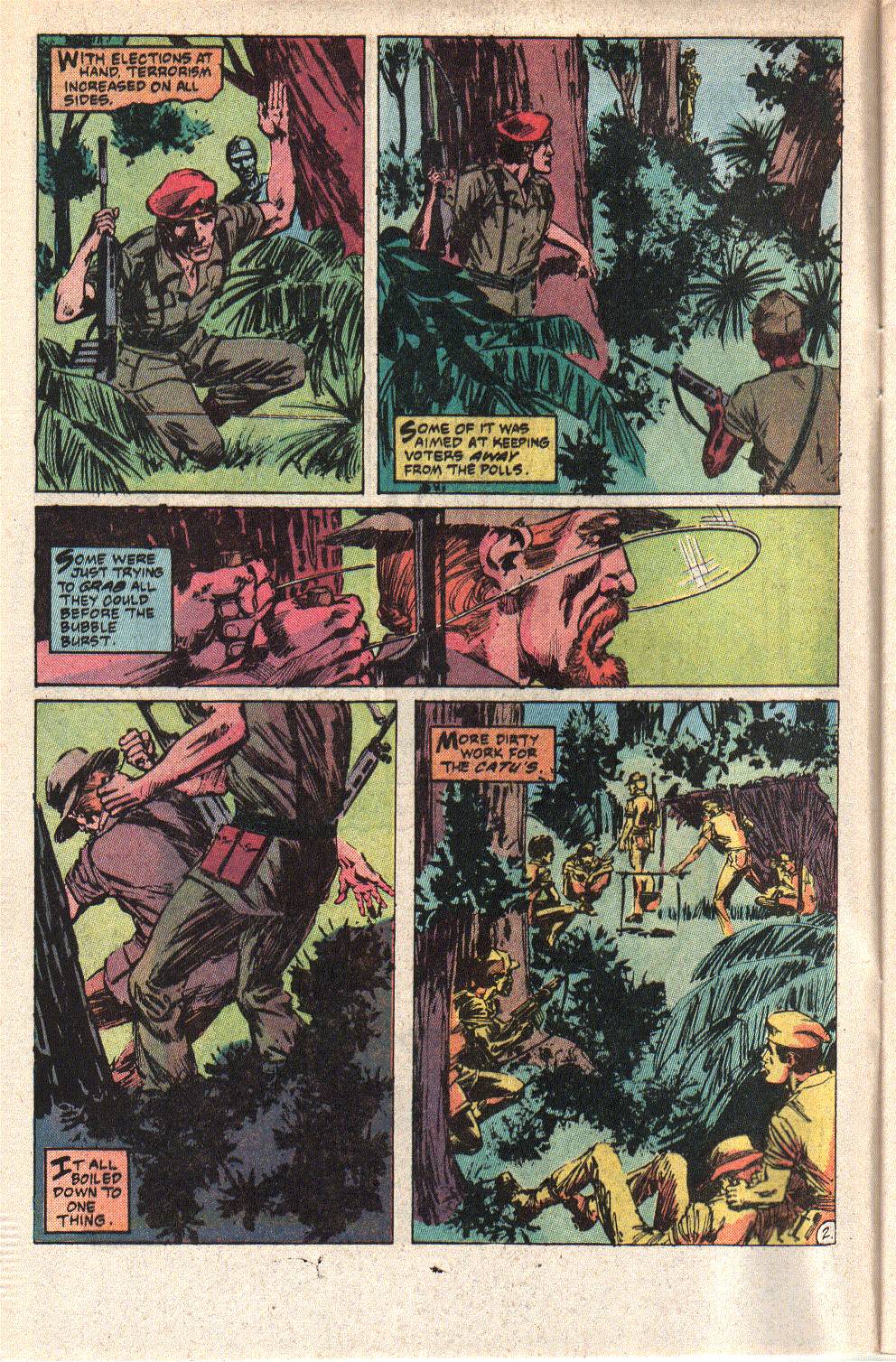 The group of a mix of white and black. They have Soviet weapons, which marks them as "enemy." The patrol opens fire, in an ambush, but one gets away. that is, until he hits a trip wire and is impaled by sharpened stakes. They move on and spot vultures and have a look. They find a dead rhino, killed for its tusks, which have been harvested and the carcass left to rot. The tracks indicate jungle boots and Sable notes that the only unit operating in the area is the Selous Scouts and it must be poachers. He remarks that if the war doesn't end soon, there will be nothing left of the country. They eventually return to their base and Jon is placed under arrest. 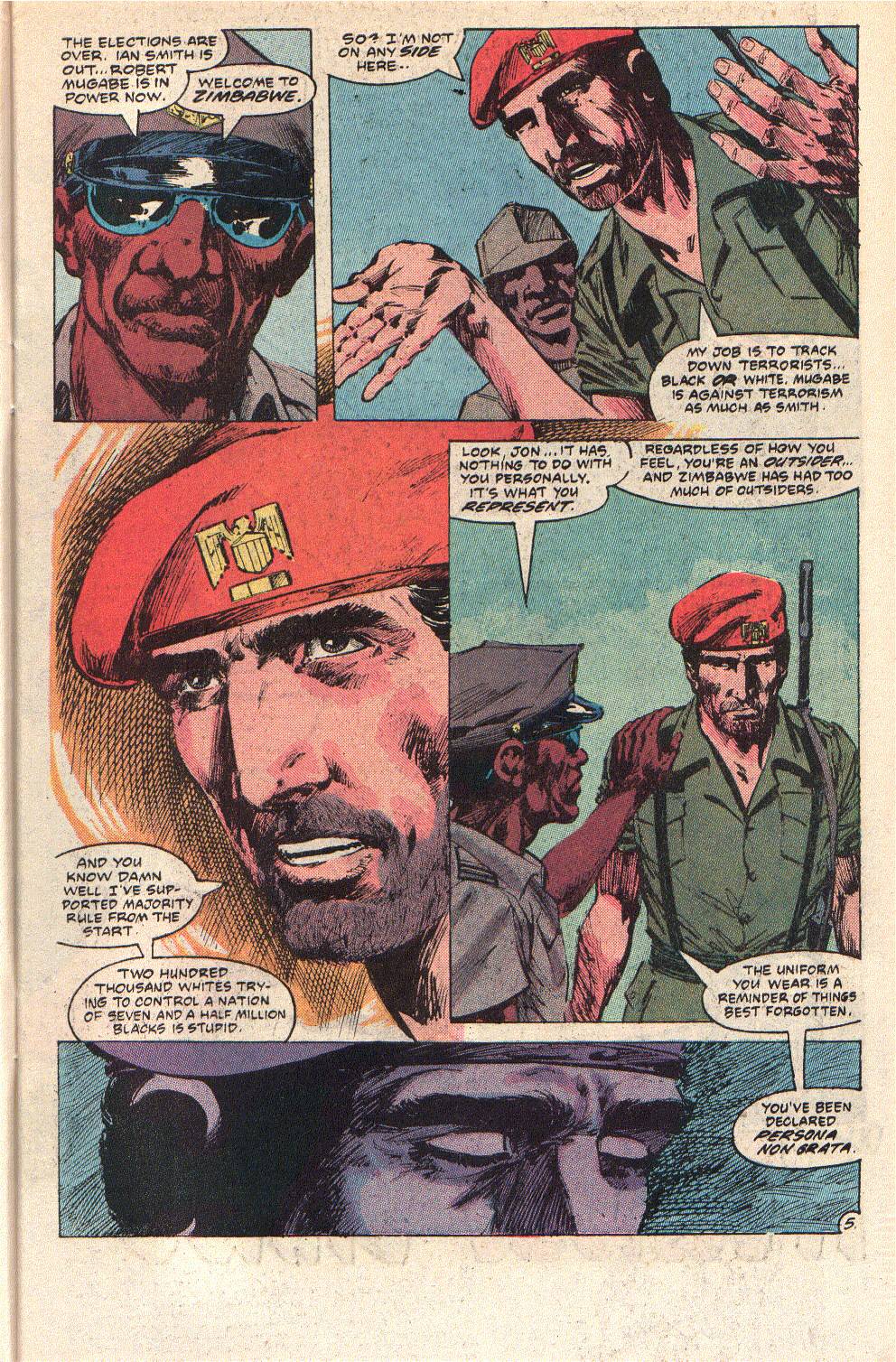 Sable is angry and defensive; his job is to catch terrorists, white or black. He supported majority rule. The officer tells him it's not personal, just politics. He is an embarrassing reminder of the past and this is modern Zimbabwe, now. On April 18, Zimbabwe celebrates majority rule and official independence, while Jon Sable is on a plane to America, alone. 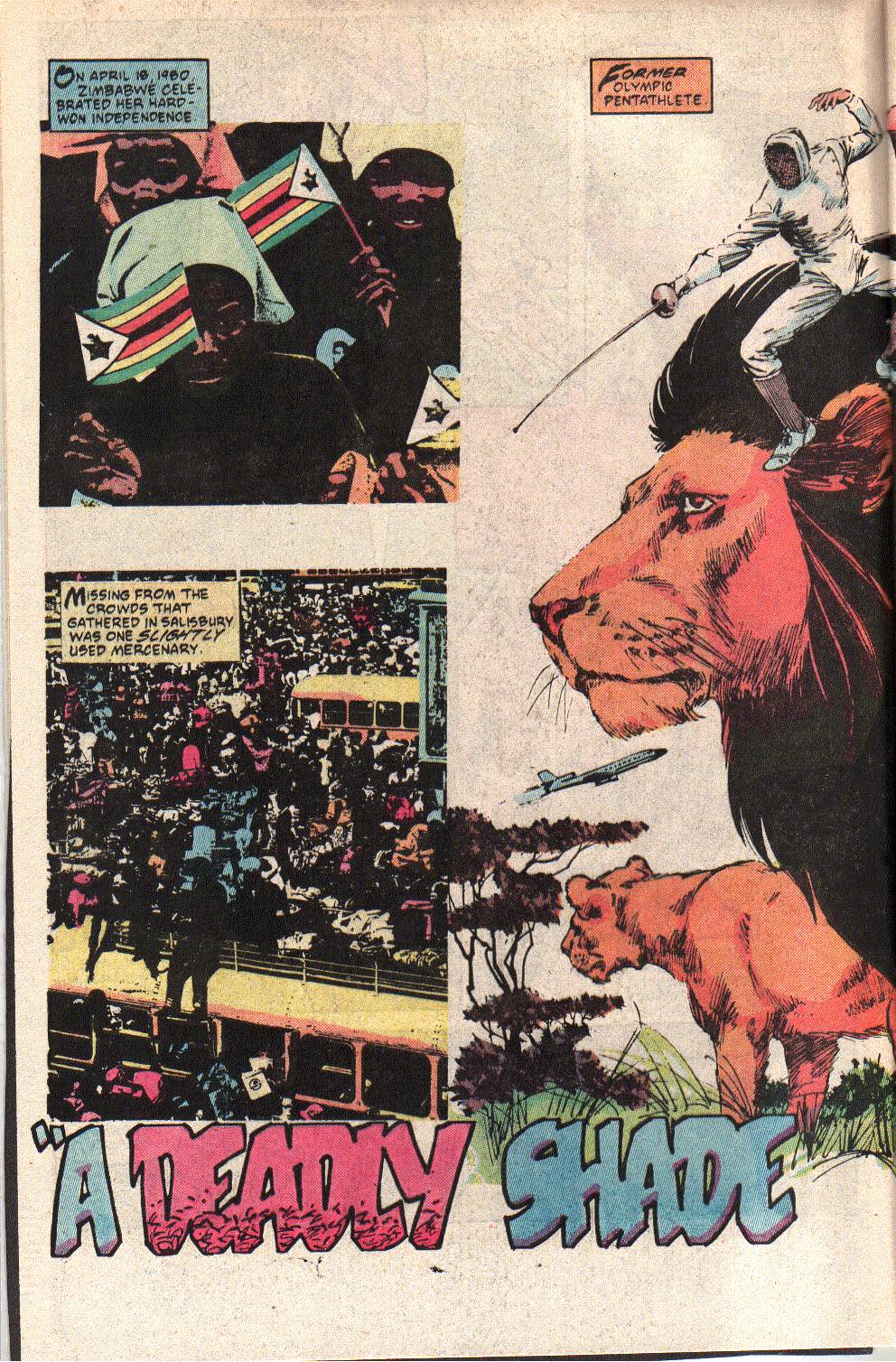 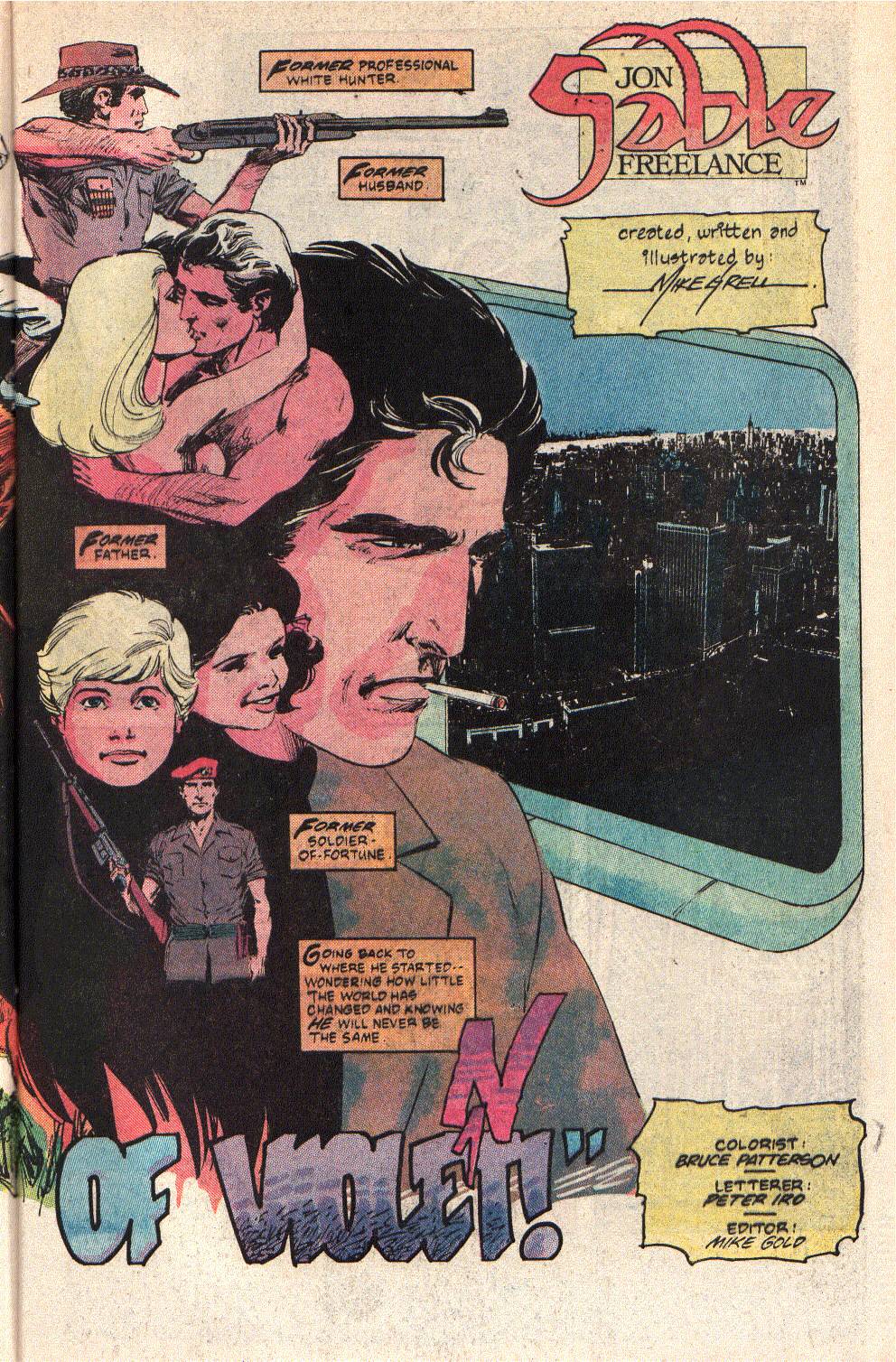 In 1983, Myke Blackmon finishes Jon's manuscript and isn't satisfied. it is daybreak. She gets dressed and goes to see Eden Kendall, at her office. she wants to know the rest of the story. Eden sees that it is important to Myke and she relates the rest. Jon returned to his old home and tried to heal. Eventually, he needed to start earning money and sat down and typed out his manuscript. He sent out copies to publishers and began his collection of rejection slips. He eventually tries a different tact and sends a copy to Eden Kendall, figuring word association might help. He eventually gets a phone call from Kendall, asking for a meeting. He arrives at a less-than-glamorous office building and meets Eden Kendall, for the first time..... 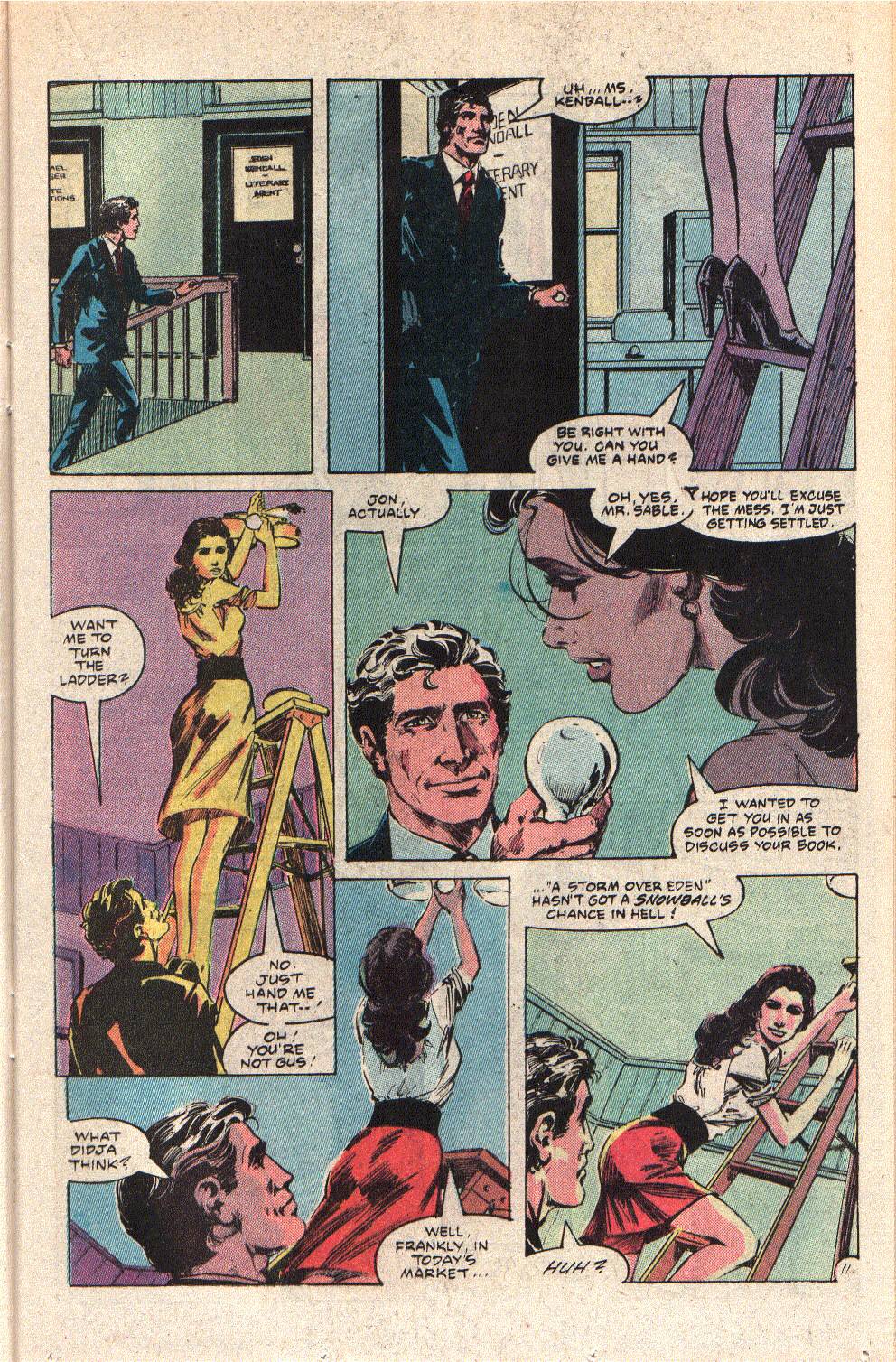 After a bit of mistaken identity, she tells Jon that she can't get A Storm Over Eden published, the market is glutted with action tales. Jon throws snark at her, asking if she hadn't had time to get her rejection slips printed and she retorts that there is something within the manuscript she can sell: the stories Jon used to tell his children. Jon is less than enthused, as he doesn't see himself as a children's author (a not uncommon snobbery, in the book world). She plays to his greed and tells him there is a lot of money to be made in the YR/YA world. He can even use a pen name, if he prefers and she offers up contracts. He mulls it over and she remarks, "Dr Seuss made a fortune on Grinches." Sable takes a pen and signs the contract, in both his name and a pen name. Eden reads out the pen name, "BB Flemm..... Flemm?....Flemm?.... Flemm." Eden went on with the work, hiring Myke to illustrate the book and doing promotion and she didn't hear from Jon for a while. He didn't have faith in the book and turned to his other skills: mercenary. He took out ads, but had no takers. Then, a child slayer, Richard dahl, escaped from police custody. Jon grabbed his gear and went hunting. Two weeks later, he trapped his quarry in his lair... 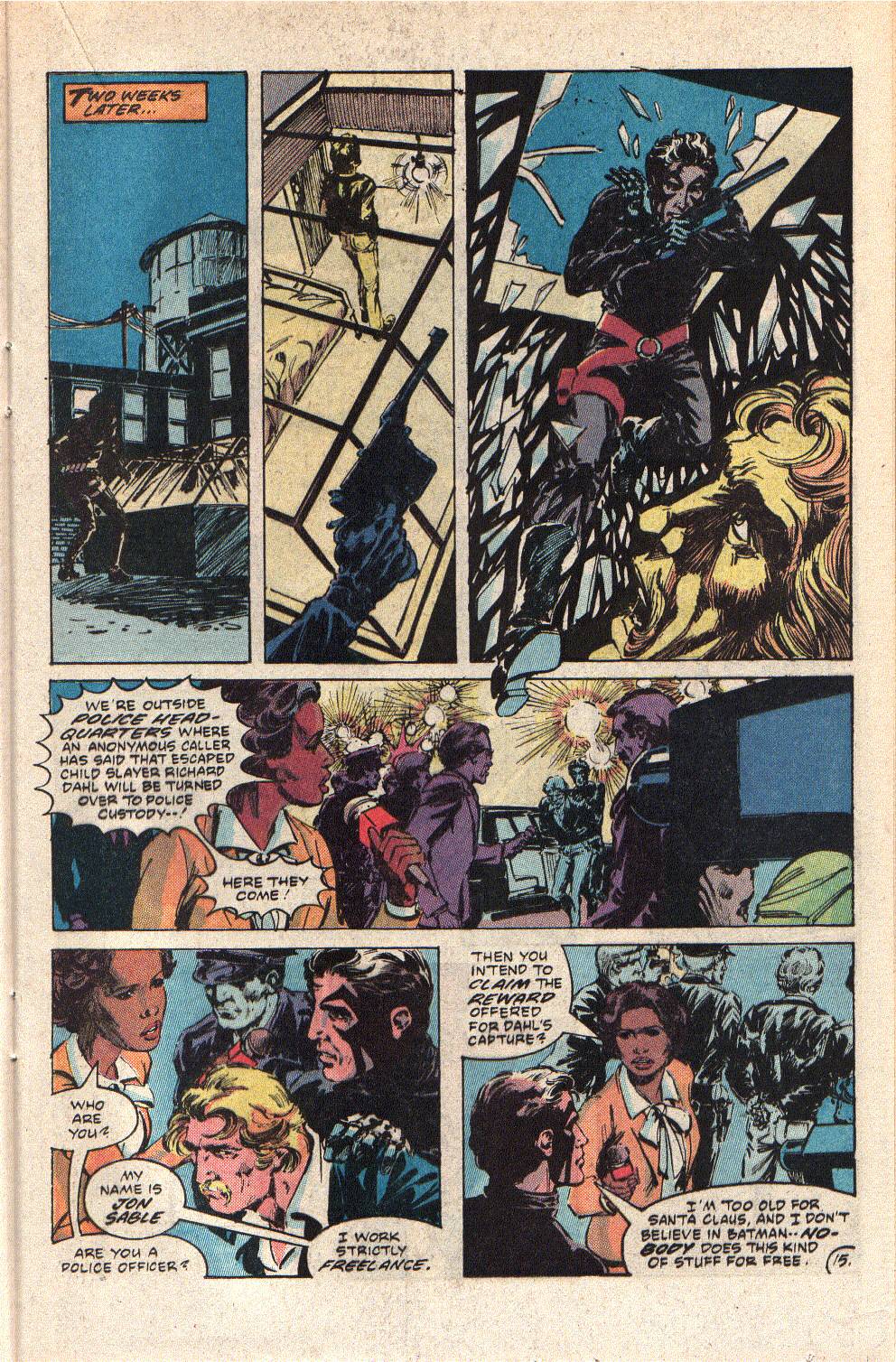 Jon brought Dahl in to tremendous publicity (and much anger and threats from Captain Josh Winters) and, soon, the offers started pouring in. Jon became a media darling, with tales of his exploits, from around the globe, growing taller with each telling. Jon allows the free publicity to increase his reputation and his fee. He is doing quite well, when he gets a phone call from Eden. She sold the book! the publisher wants to rush it out, in time for the holidays. She has set up a book signing appearance the coming Saturday, at Scribner's. Sable protests that he didn't agree to appearances and Eden tells him to read the terms of his contract and threatens to sue him for everything he has, if he reneges on the deal. She tells him to relax; he stands to make a fortune. Jon collapses on his bed, in despair. Sable's face has been plastered all over the media and he knows he can't show up at a signing for a children's book. Thus, on Saturday, the world meets author BB Flemm, who isn't happy to make their acquaintance... 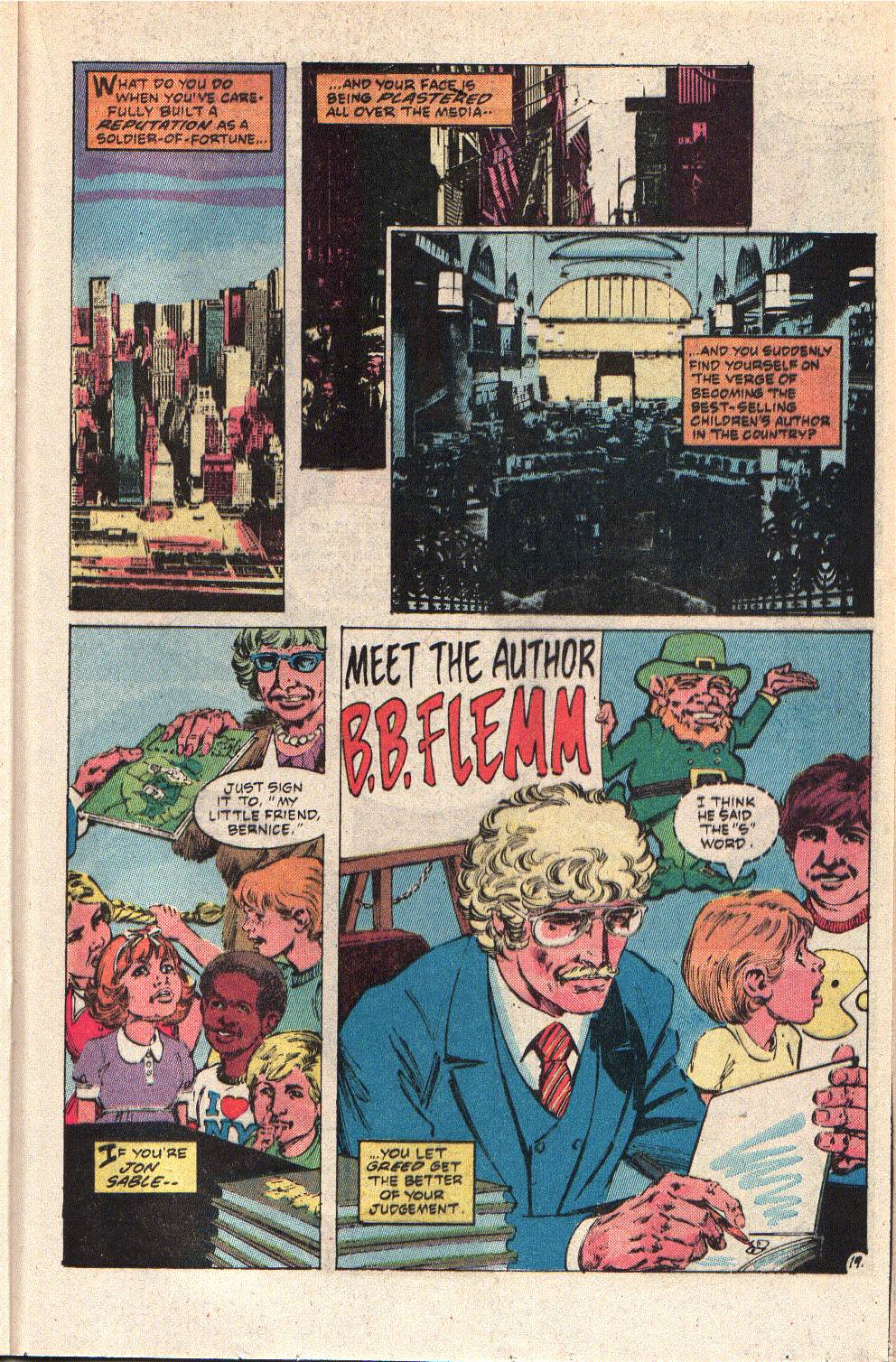 Myke still doesn't get why he continues with the danger, given how much the books earn, with toys and tv specials raking in the money, on top of the sales. Eden repeats something he said about being truly alive when in danger, which she thinks he got from a comic book. Her theory is he is too greedy to give up writing and having too much fun to give up the danger. Now, we move on to Zimbabwe, as Jon moves in on the men waiting to ambush him, at the remains of his old life. One by one, he quietly eliminates them, until there is only one left. After a brief firefight, the man goes down, gutshot and Sable tells him he can die easy or hard and asks for the name of the man who sent them. The dying killer gives up the name Reinhardt Pyke. Sable has never heard of him. He asks where to find him. Sable takes the killer's land rover and drives to Salisbury, to the address indicated. He isn't stupid and he scales the outside of the building to get to Pyke's penthouse. Pyke dismisses a lady friend and goes to the glass window and looks at his reflection in the glass, straightening his tie. There is a lion's tooth, dangling from his wrist, set in a loop. Sable's hands crash through the glass and clutch his throat.... 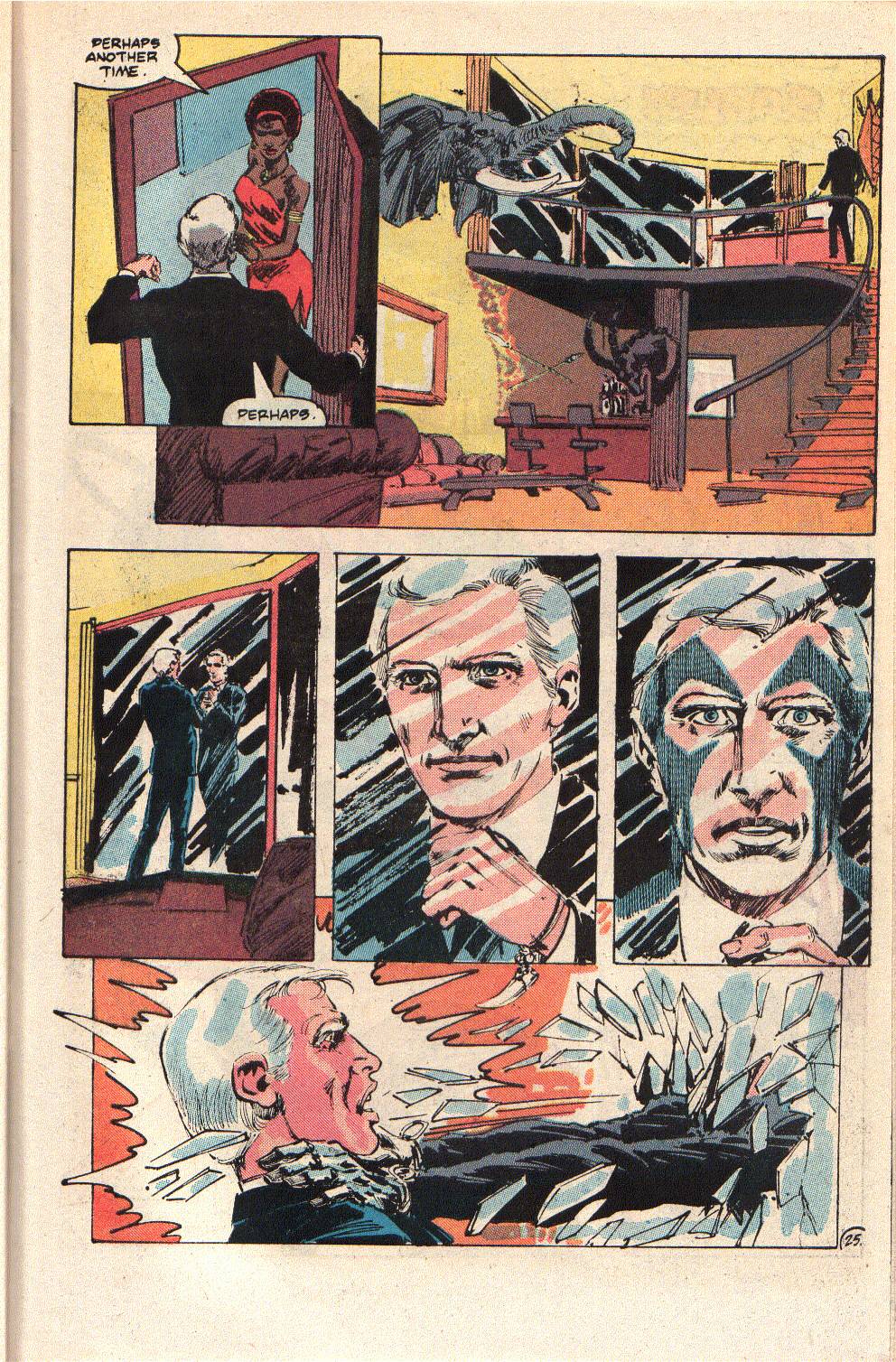 Sable has lost all control and only wants to kill. Pyke, in desperation, grabs a telephone set and clocks Jon across the head, stunning him. Pyke then grabs a spear from a wall display and poises to stab Jon. Jon rears up and guts him with the punch daggers from his belt buckle. He asks who Pyke is and Pyke says he will never really know, and falls over backwards, over the railing and is impaled, ironically, on the horns of the stuffed head of a sable antelope. Jon prepares t leave and finds a telegram, congratulating Pyke on becoming head of the national parks, for Zimbabwe and how the sender looks forward to increased business. It is signed, "J." Sable realizes that Pyke was about to gut the wildlife of the region, with official sanction. Jon returns to his homestead and places violets on the grave of Elise and the kids and leaves the lion's tooth necklace on the cross. Thoughts: A terrific ending to Jon's origin tale, with a mix of his manuscript, Eden's narration and the conclusion of Jon's return to Zimbabwe. We get a mix of how Jon saw his story and how Eden did, how she tapped into the part of his tale that not only made him rich, but also gave him a conduit to the spirit of his kids. Finally, Jon is finally able to gain retribution for their murder and find a bit of peace. The part about falling into children's literature, while trying to be a novelist is not unusual. Rick Riordan, who wrote the Percy Jackson series of YA novels, started out writing mystery and true crime, while teaching school. Ian Fleming wrote Chitty Chitty Bang Bang, based on bedtime stories he told to the children of a friend (he had no children of his own). Dr Seuss started out doing advertising cartoons and editorial cartoons, before coming up with the rhythm of To Think That I Saw It on Mulberry Street, while on a cruise ship, listening to the engine noise. However, not many have been noted soldiers of fortune, who hide behind a curly wig, mustache and glasses, at book signings and interviews. The scene at the signing is a hoot, especially when one kid whispers, "I think he said the 'S word'!" I've handled several book signings and can only imagine how bonkers they made Sable, especially if he is sweating away in his disguise. However, down the road, we will see that, sometimes, Jon makes the best of his fame, as an author. The quote Eden relates from Jon is "You have never lived until you have almost died. For those who fight for it, life has a flavor that the protected will never know." Myke isn't impressed and Eden jokes that she thinks he got that from a comic book. Well, it's an in-joke, as Sable did get it from a comic book; a Mike Grell comic book: The Warlord. From Warlord #3... 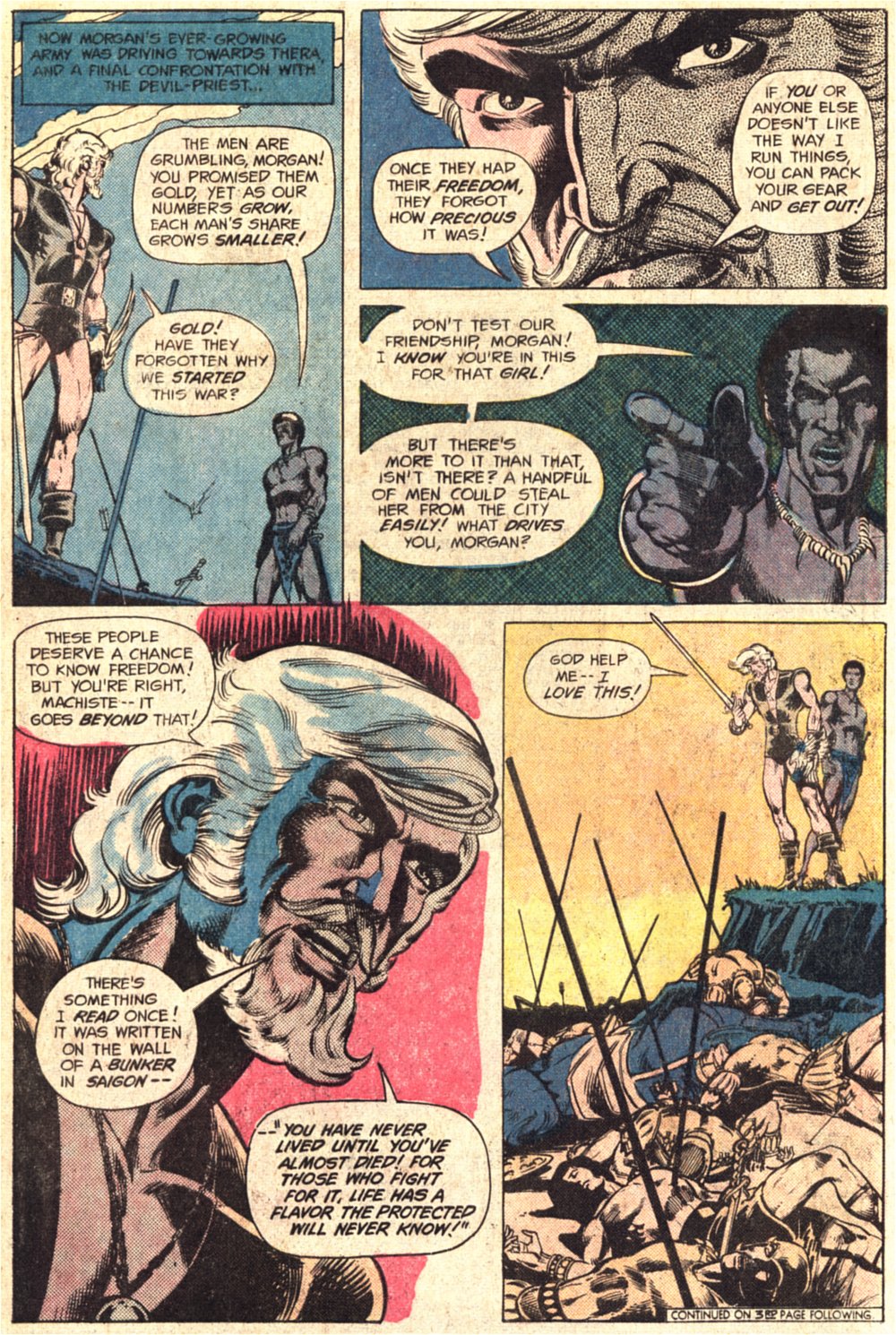 Travis Morgan claimed to have read the statement on the wall of a bunker, in Saigon. I never asked Mike Grell if he had or if he just made it up (though I have read such sentiments in other comic books and adventure novels and films). Our first glimpse of Eden, in the past, is a shapely leg, perched on a ladder, in a skirt and high heels, trying to change a light bulb. it helps establish Sable's appreciation of her beauty, while he soon comes to respect her business skills. For her part, as we see in the present, she considers Jon a friend and a client, occasionally a lover; but, not a romantic partner. Myke wants to know the man and it becomes clearer that it is more than just understanding the schizophrenic nature of his identities. Perhaps she sees some of what Elise saw in Jon? At the start, Grell has Jon leading a CATU; but, he says the acronym stands for Civilian Anti-Terrorist Unit. He is mixing up his organizations. The British South Africa Police developed two groups for tracking down "terrorists": The Police Anti-Terrorist Units and the Civilian African Tracking Units. PATU and CATU. The PATUs were a police paramilitary formation, made up of black and white officers, who fought guerillas, in the bush. The usual formation was a "stick" of 5 men, usually 4 whites, led by a black officer, who acted as a tracker. They carried out long range reconnaissance and ambushes, in the bush. The PATUs were formed in 1966 and operated until majority rule, in 1980, when the BSAP were disbanded. The CATUs were formed in the late 70s, primarily consisting of black trackers, with a couple of white officers, who relieved the PATUs and military of the tracking aspects, acting as more of a support and reserve force (more like a militia), allowing units like the Selous Scouts to carry out the military aspects of the work. What Grell shows, with Jon leading black trackers, is the basic CATU; he just mixed up the terminology. What we saw in the previous issue seemed to be more of a military operation, like the Selous Scouts or Rhodesian SAS or Rhodesian Light Infantry (all Rhodesian special forces formations). Rhodesia did not have mercenary formations, like the Congo; foreign volunteers enlisted in the Rhodesian military structure. The PATUs did have some South African police, working in an exchange program; but, they proved unpopular, as their pro-apartheid attitudes alienated the black officers and reduced unit efficiency. Sable's expulsion also reads true, as majority rule was swiftly followed by a dismantling of the former mechanisms of the white minority government and colonial powers, including the BSAP. Foreign soldiers were deported and then Mugabe soon turned his attention to intimidating white citizens into leaving the country. Many had lived their their entire life and had been born in the country and saw it as their home. Many had voted for majority rule and respected their fellow Africans and interacted well with them. However, years of anger and oppression caused many changes and even the friendly whites soon found themselves pariahs. Many others had exploited the minority rule and were the first to be targeted and large groups of them left the country when it became clear that majority rule was coming. Some carried out acts of terror and intimidation, especially in the period leading up to the vote that put Robert Mugabe into power. Regardless, Grell tries hard to make Jon's work there sympathetic; but, the reality is that the bulk of the focus of the PATUs and CATUs, as well as the military, was in locating and attacking ZANLA and ZIPRA formations. As in most guerilla wars, one man's "terrorist" is another's "freedom fighter." the Sons of Liberty were branded "terrorists" by the British colonial authorities; we call them Patriots. We get into the nitty gritty details of Jon's first foray into mercenary work, in the US, as we see the "Dahl Case," referred to in issue #1. What we don't see is how Jon was able to find Dahl, but not the police. It smacks a bit too much of miracle, without seeing Jon pursuing a line of evidence not open to the police. Realistically, bounty hunters work for bail bond companies, hunting down people who skip bail, to secure the bondsman's money. Their fee is usually a percentage of the original bond. One of the most famous, in the pre-reality tv era, was Ralph "Pappa" Thorson, the subject of Steve McQueen's last movie, The Hunter. He was a bit less colorful than Dog the Bounty Hunter. Another relatively famous one was David Schultz, the former pro wrestler who famously slapped John Stossel, on a 20/20 piece about the then-hot topic of pro wrestling. He was fired by the WWF and soon found that other promoters didn't want to touch him, because it was felt that he brought too much negative publicity (and he was hard to deal with, for some promoters, especially Verne Gagne, since he skipped out on the AWA to go to the WWF). He turned to working as a bail bondsman and bounty hunter and was quite successful. Bondsman usually have a place to start and have contacts that allow them to trace their targets. In most cases, their crimes are not severe enough to warrant the police expending large numbers of resources in a manhunt. Anyone like a child slayer is not going to be out on bail. In the story, Dahl escapes while being transported to Attica. This would put him into the jurisdiction of the US Marshal Service, as well as the NYPD and New York State Police. It seems unlikely that Jon would have avenues that they could not pursue. However, the point of the case is to show that Sable is a skilled hunter of men, in an urban setting and establish his notoriety, as well as his conflict with Josh Winters. That goes back to the PI element of the original Iron Mike concept, with the mixture of "James Bond and Mike Hammer." Finally, we come to the conclusion of Jon's hunt for the man who killed his family. As far as Jon knew, the white-haired man died at the waterfall, when he slipped over the side, after Jon severed his pinky finger, with his knife. However, someone still tried to kill Jon, the previous year, when he tried to slip back across the border, to visit his family's graves. Now he knows, that the man responsible was "the white-haired man," Reinhardt Pyke. Pyke survived and had set himself up as a man of influence and power, as he is a white man, who is given a position of authority, by the Mugabe regime. That wasn't necessarily too far fetched, that soon after majority rule; but, it wasn't very likely. Pyke would have to have offered huge bribes to secure the appointment, with the promise of a cut of the proceeds. That seems very likely, as we know, from the previous issue, that the ivory cartel was still in operation and had enough influence to get a courier into the country for a large payoff, with narcotics. Pyke was set to be able to create protection for the poaching operations, while also keeping out rival poachers. He could control the level of poaching, making it an organized thing, to keep the herds from being killed off, until they could harvest more ivory and also manipulate the price. It is basically organized crime in the African Bush. Sable ended that with one (pair) knife thrust. However, as we see, Pyke had allies, elsewhere and the identity of J will be at the center of a future story. The issue also serves to explain why Jon had to slip across the border into Zimbabwe, rather than fly there. He is deported as persona non grata, after majority rule; and, therefore, would be unlikely to obtain a visa to legally enter the country. So, he, instead, travels to Botswana or Zambia and crosses the border, illegally, through the bush. This is not too hard, though the bush lands are a hostile place, between animals, snakes, disease-carrying insects, unsafe drinking water, poachers, and government patrols. Sable is an experienced tracker and bush expert; so, it proves no problem, for him. Later, we will see that he returns to Africa again, and finds himself hunted again, likely by the people backing Pyke, though it is a bit nebulous, in the story (we'll get to that, later). Now, Jon is fully established and his supporting cast is mostly in place. Next issue will introduce one of my favorites, and return Jon to his urban adventures. One last note: the previous issue included a letter from TM Maple, the prominent letter hack of the 80s. This issue includes a letter from Malcolm Bourne, a noted correspondent from the UK, whose letters were often seen in comics like Grendel, Miracleman and several other independents. There is also one from David Campiti, who would write some scripts for Pacific and DC, then was heavily involved in the early days of Malibu and its subsidiary imprints, before founding Innovation Comics. At this point, First Comics now consists of 6 titles: Warp, E-Man, Jon Sable, Starslayer, American Flagg and Mars (the newest of the bunch). soon, it will be joined by Grimjack, provide a home to Nexus, Badger and Whisper and then expand some more. They were quickly becoming the independent company to watch, in 1983.
|
|
|
|
Post by foxley on Aug 17, 2021 3:13:42 GMT -5
Edgar Rice Burroughs also started his storytelling career telling an elaborate bedtime story to his children. As the story went on, it got so complicated that he started writing it down after he had told it to his kids so he could keep the details straight. Decades after his death, this longhand manuscript was found among some of Burroughs papers. It is called Minidoka: 937th Earl of One Mile Series M, and Dark Horse published it as an illustrated novel (with illustrations by Mike Kaluta!) in 1998. Written in 1903--nine years before his first professional work--it is an interesting read, if not as polished as his later stuff, and you can already see the germ of ideas that would be developed in in his later works (especially the John Carter books).  |
|
|
|
Post by codystarbuck on Aug 20, 2021 23:27:10 GMT -5
Jon Sable #7 Sable looks kind of awkward on this one. The stance is all wrong, off balance. I suspect that is, in part, because Grell needed him to help cover the naughty bits of the cover nude. Indicia Gag: Pay attention. There will be a short quiz later. Looks like they are sticking with the same gag for two months. We'll see if the pattern holds. Creative Team: Mike Grell-story & art, Peter Iro-letters, Janice Cohen-colors, Mike Gold-editor Doug Rice joins the First staff, as production assistant. He had produced some fanzine stuff and had been published in the india anthology, Just Imagine. Dog would go on to do Dynamo Joe, for First, then hop over to DC to do Manhunter, with John Ostrander. Synopsis: Myke returns the manuscript to Eden and asks about where he has been. Eden says she tries not to think about it; but, he usually returns from one of these "escapades" with a new scar. She says she knows where he better be....and we cut to LA, where author BB Flemm is chatting with Nebraska's favorite son.... 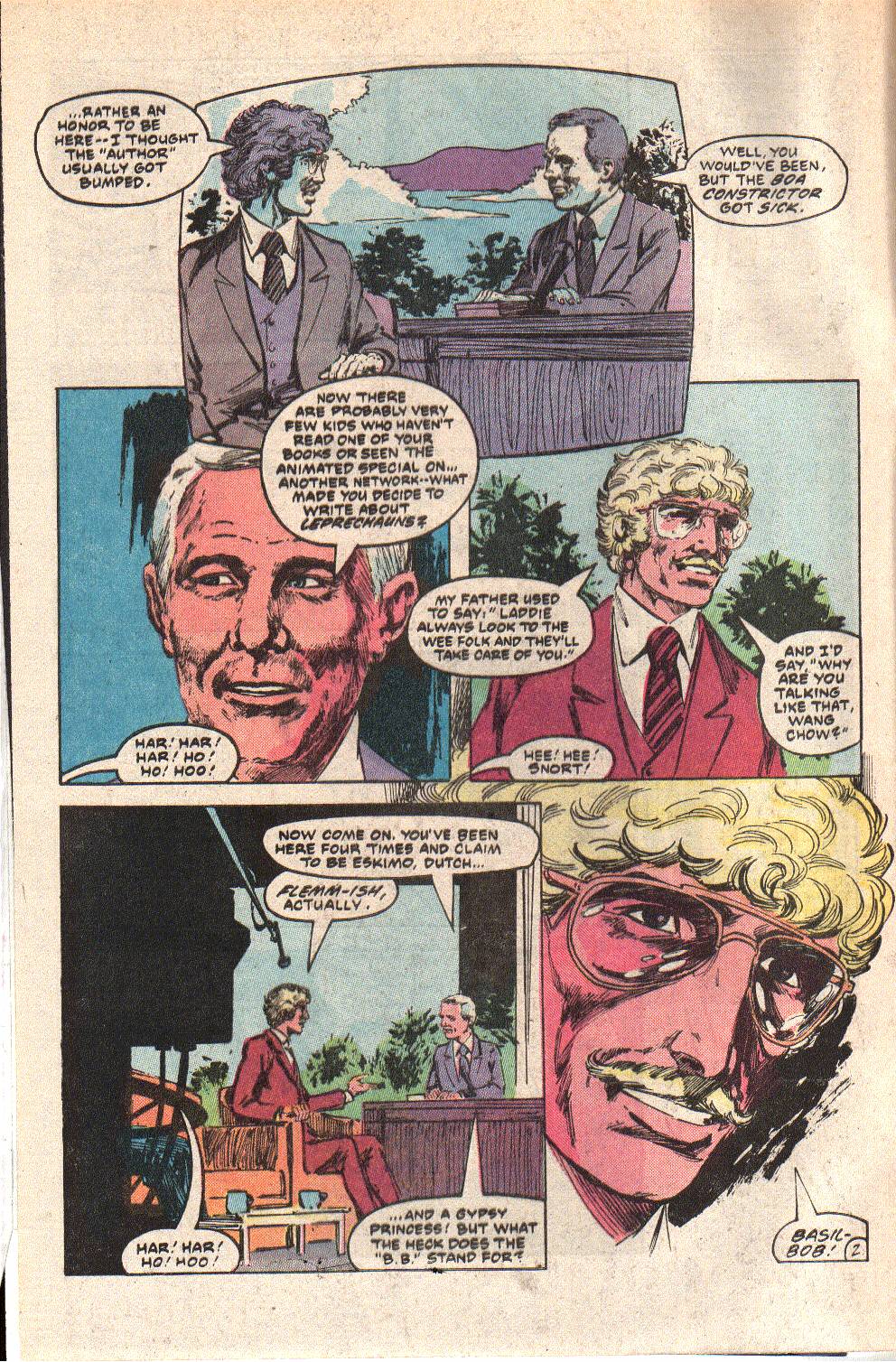 When the show comes back from the break, Johnny introduces his next guest, a renowned stuntman, Jason "Sonny" Pratt.... 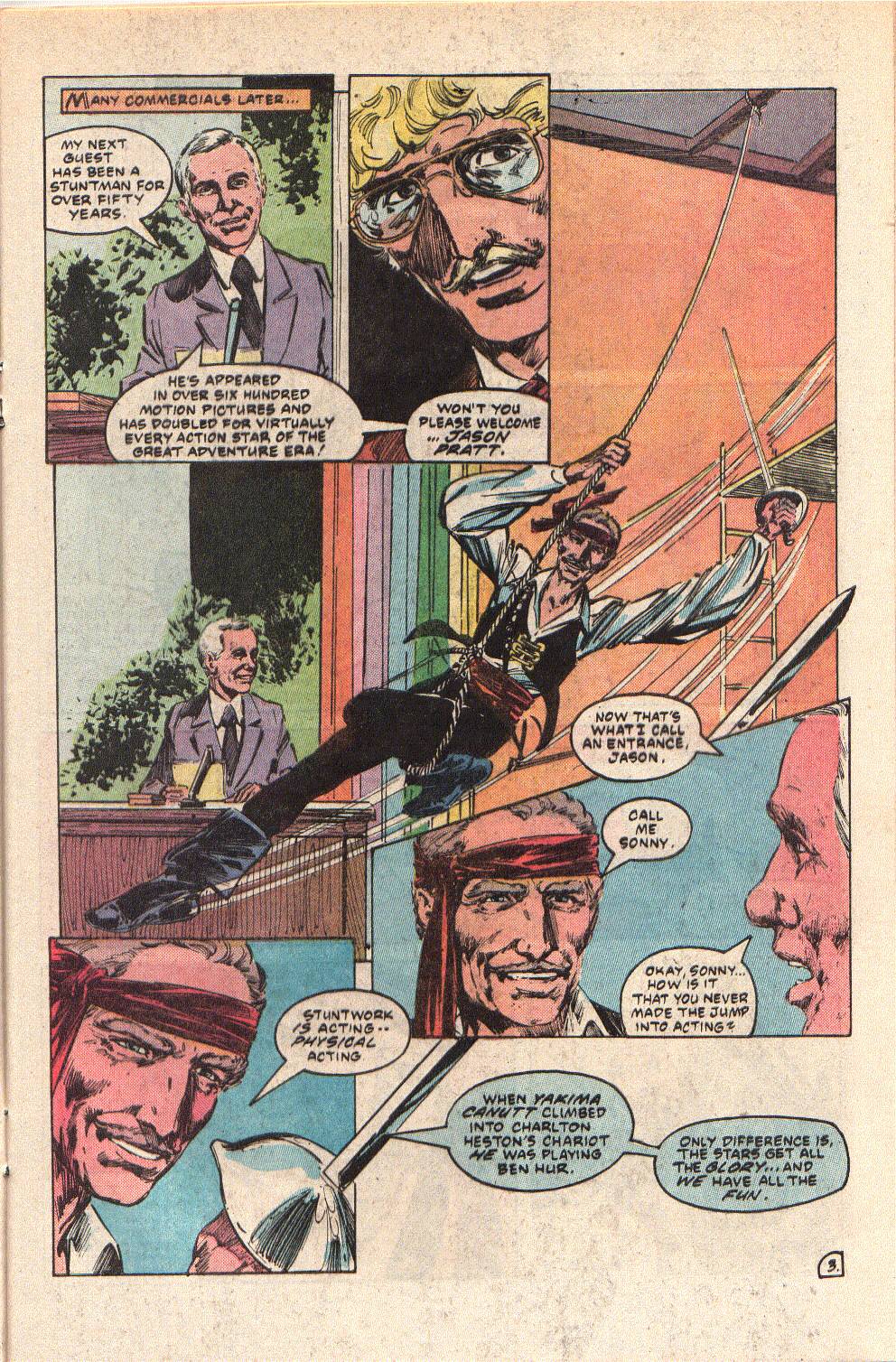 BB Flemm is noticeably agitated. Sonny gives Johnny a fencing lesson and mentions a hot Olympic prospect he coached, in '72, named Sable, but the guy never followed through. Flemm hides his head and sinks low in his chair. Later, Flemm, aka Jon Sable, meets up with Sonny and thanks him for not blowing his cover. Sonny asks why the disguise and Sable says he is too embarrassed to be known as a children's author, but there is too much money in it to stop. *COUGH* .......ah-bulls@#$!......*COUGH* Elsewhere, police move a star witness in a trial to a new location. Their timing is terrible.... 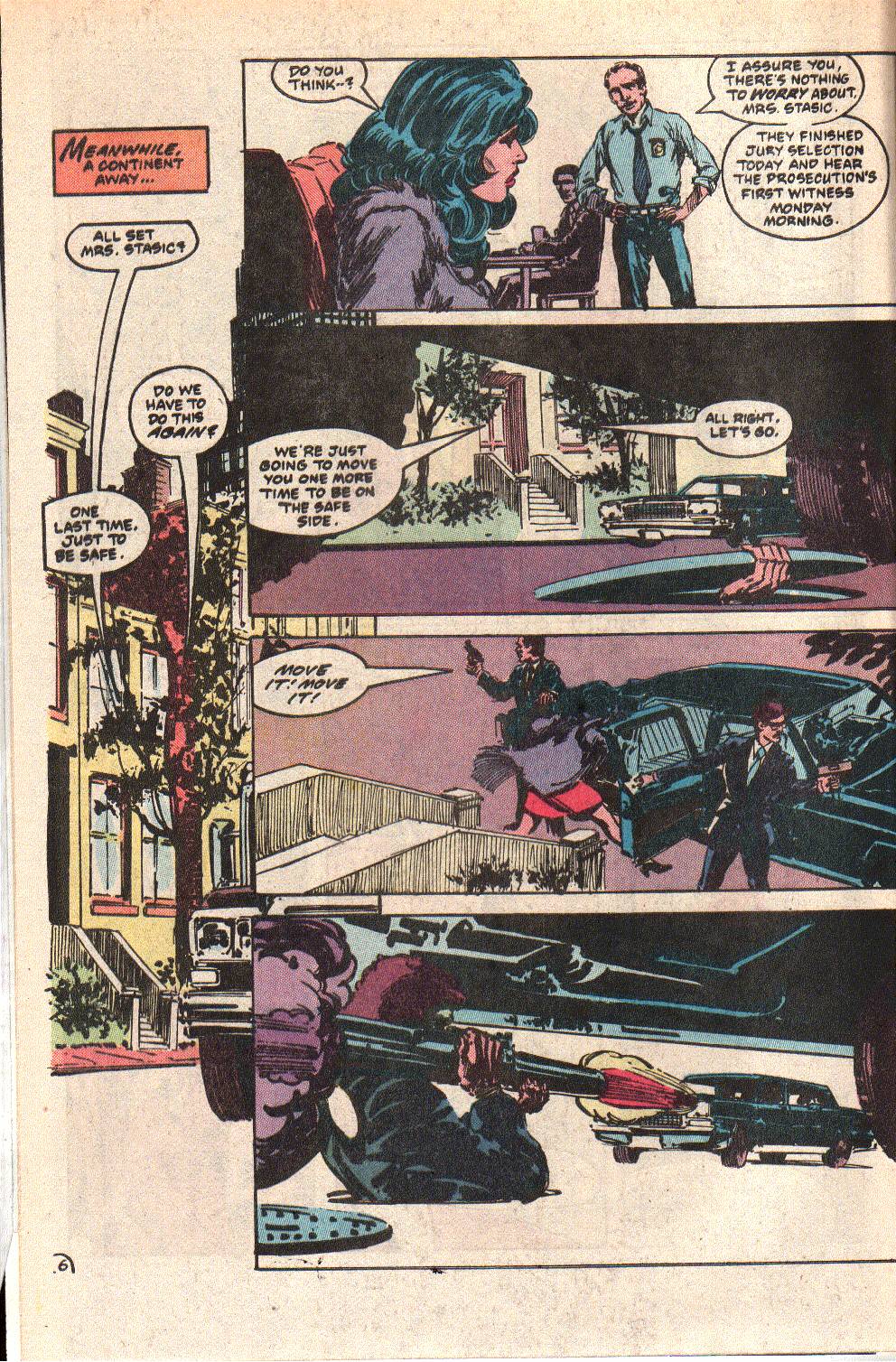 Turns out, they hit the decoy vehicle, as the witness watches from a window. the cops call for back up and when they turn around, their star witness has bolted. Jon catches up with Sonny, in a bar, while The Adventures of Robin Hood plays on the tv. Sonny laments that they don't make films like that anymore and the old days are gone. Jon, in a melancholy mood, adds, "For all of us." Sonny asks what happened to Jon and Sable passes it off as getting old, but Sonny isn't biting. He says Jon found the killer instinct he lacked, as a pentathlete. Jon gives him his New York address and says to see him when he next hits New York. Sonny tells him to lay off the cigarettes, as he pulls one from Jon's mouth and stubs it out. Jon says goodbye and leaves. Later, in New York, Jon checks his messages and finds one on the machine that mentions the headlines... 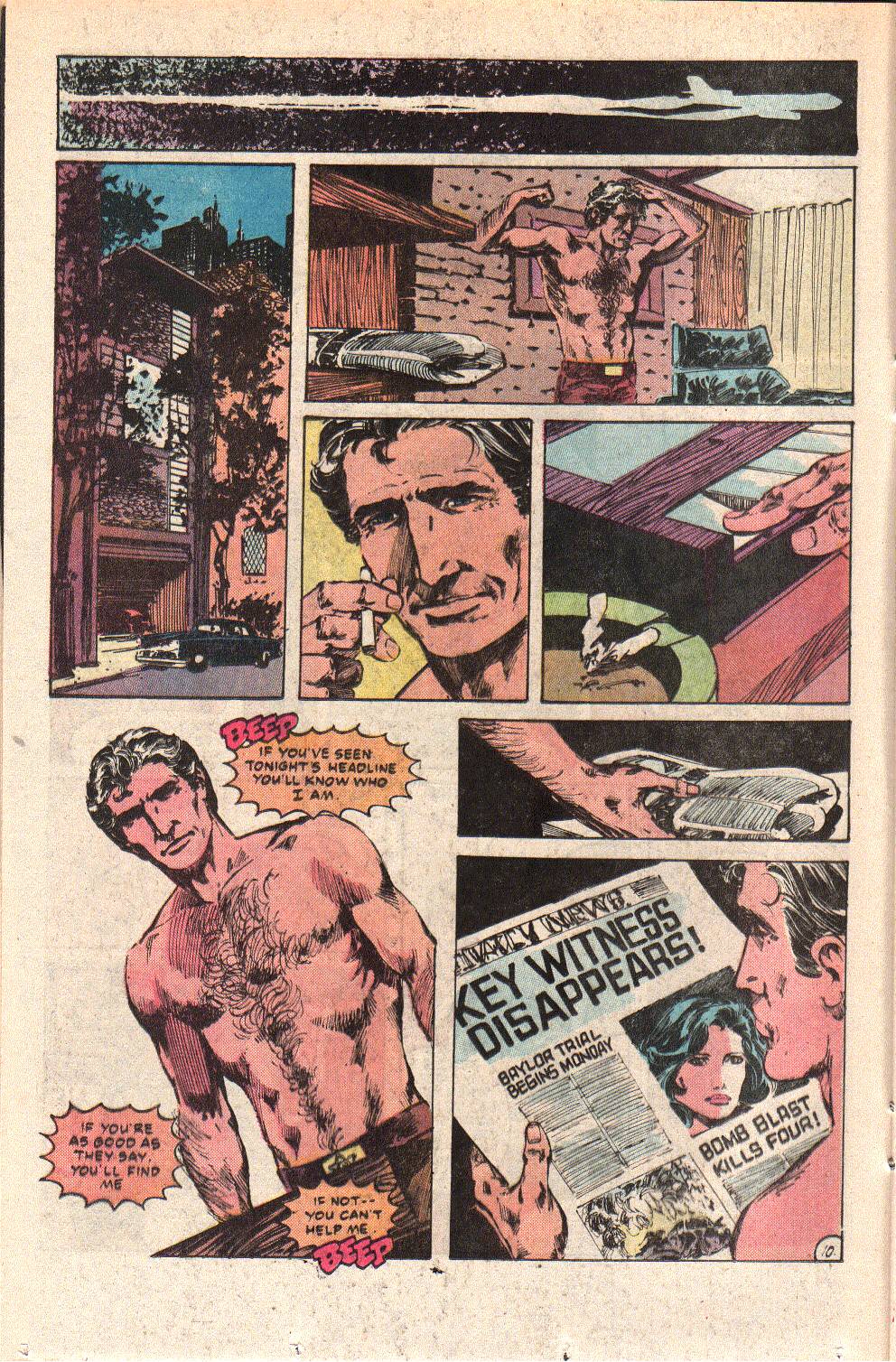 Sable calls Harold, the police file clerk and gets the dossier on Andrea Stasic, the witness. he came to New York to be a dancer and met up and married a mobster, while working in a strip club. He was gunned down by an old crony and she saw the whole thing. Sable asks the name of the club were she danced and goes there to look around....for his client......no other reason.........to find the client.....yeah, that's right. Jon asks for the woman by her birth name and claims to be a cousin. The bartender claims to have only been there 6 months and tells him to ask Tilly, backstage. Sable runs into muscle when he goes back there, who says he is Tilly. Sable quotes The Day The Earth Stood Still and says he is Andrea's cousin and Tilly slams him into the overhead pipes. Sable kick Tilly in the face and they are about to get nasty, when a woman stops Tilly. It's the blond from the stage and she asks Sable want he wants. he says he is looking for Andrea Hurley and she sent for him and shows his card. The dancer removes the blond wig and asks Sable if he ever read Poe's "The Purloined Letter." It is Andrea Hurley Stasic. Shots ring out and Tilly comes falling down the stairs, shot in the chest. Sable returns fire and hustles Andrea to the back door, but a hood is waiting, with an Ingram submachine gun. Andrea pulls out a Derringer and fires both barrels, point blank. Sable holds off the rest of the crew with his Schnellfeuer Mauser and he and Andrea escape in his Studebaker. Sable takes her to Eden's apartment and wakes her. She thinks Sable is there for a booty call, when she sees Andrea and gets catty. Sable asks for her car, some food, and the camping equipment they used, previously. he introduces Andrea and asks if she can get her clothes. Eden stares at Andrea's bust and says she might have something that fits. Sable says he will make it up to her and they go to hide out from the killers.... 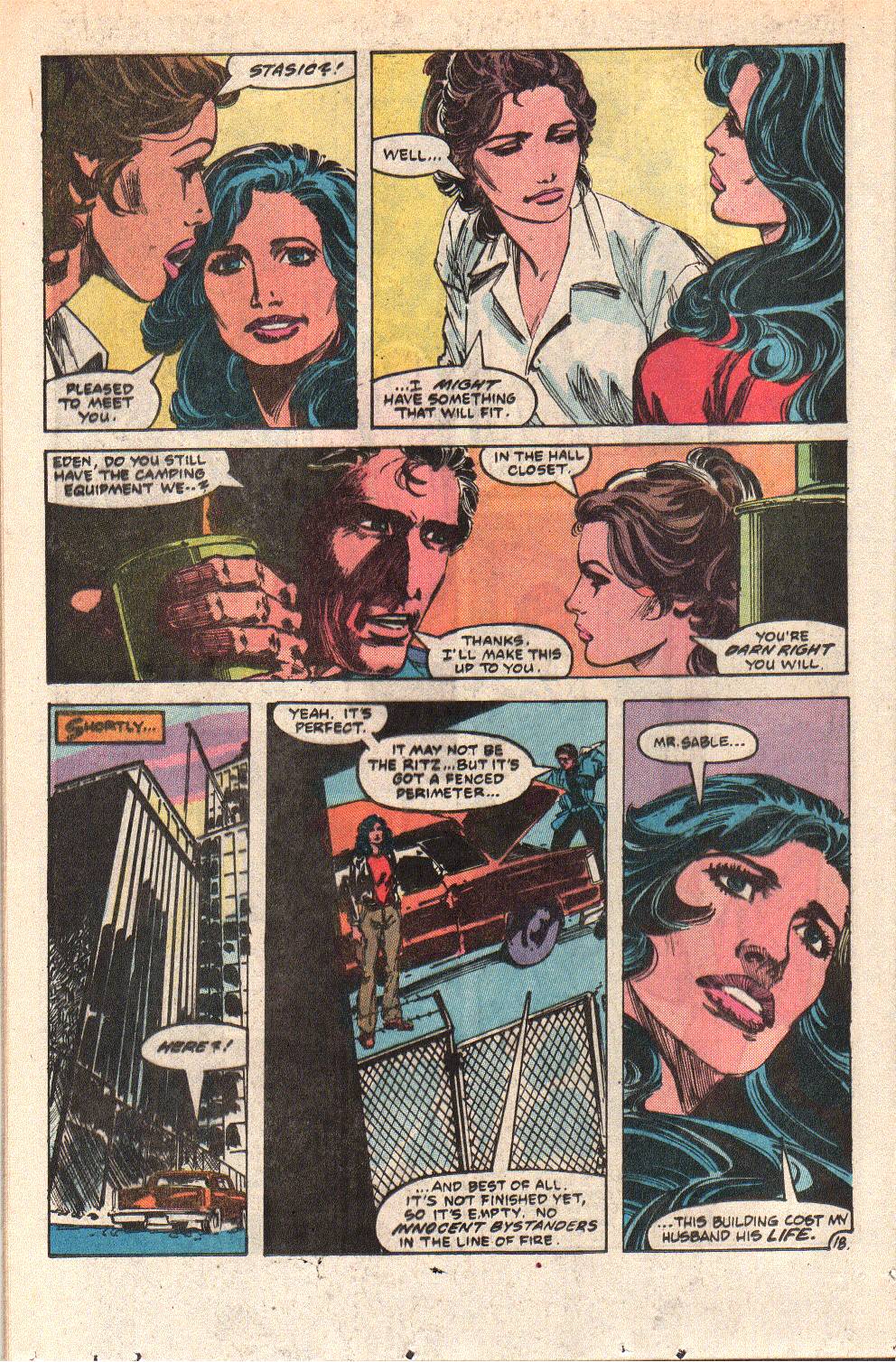 Andrea says her husband died because of the building they arrive at. They take an elevator to a partially finished penthouse and Sable then blockades the entrances. Andrea tells Sable about her husband and the murder... 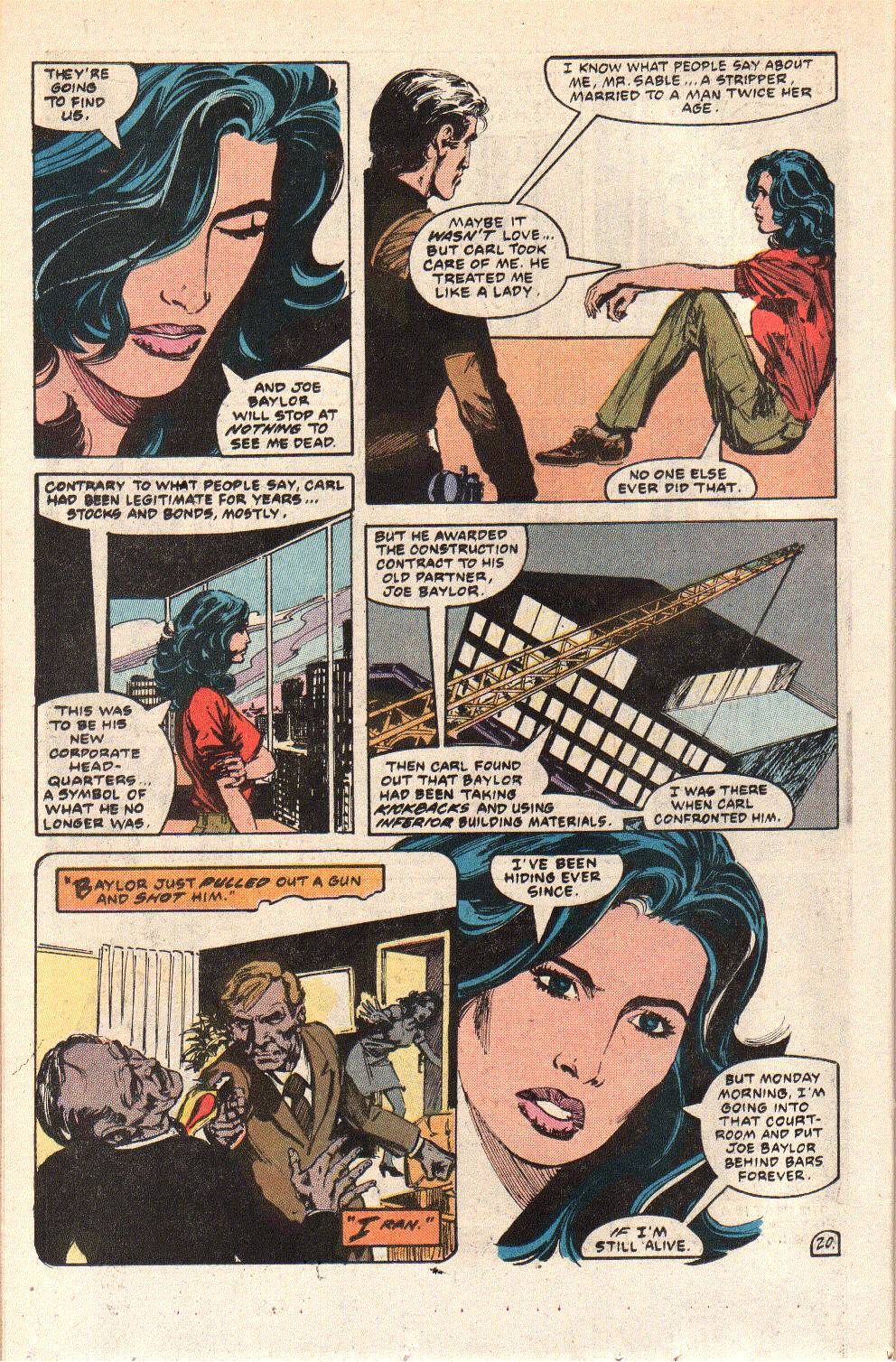 They bed down and wait for Monday, to get Andrea to the courthouse. They cook over a camp stove and are ready to eat, when cars arrive. Sable gets ready for the first wave. They take the stairs, but find Jon's barricade, then Jon surprises them, from behind. Jon then notices a crane bucket going up to the top and leaps for the railing, above the barricade and runs for Andrea. he shoots through a wall and crashes through the drywall to flatten her, before the shooters in the bucket open fire. He dive rolls into the room, grabs the Coleman lantern and smashes the glass and flings it into the bucket, setting the shooters on fire, causing them to fall out. He then shoots the crane operator. He counted 10 men upon arrival, but has only accounted for 7. Andrea spots Joe Baylor and Sable realizes what the other 3 were doing, as Baylor sets off demolition charges... 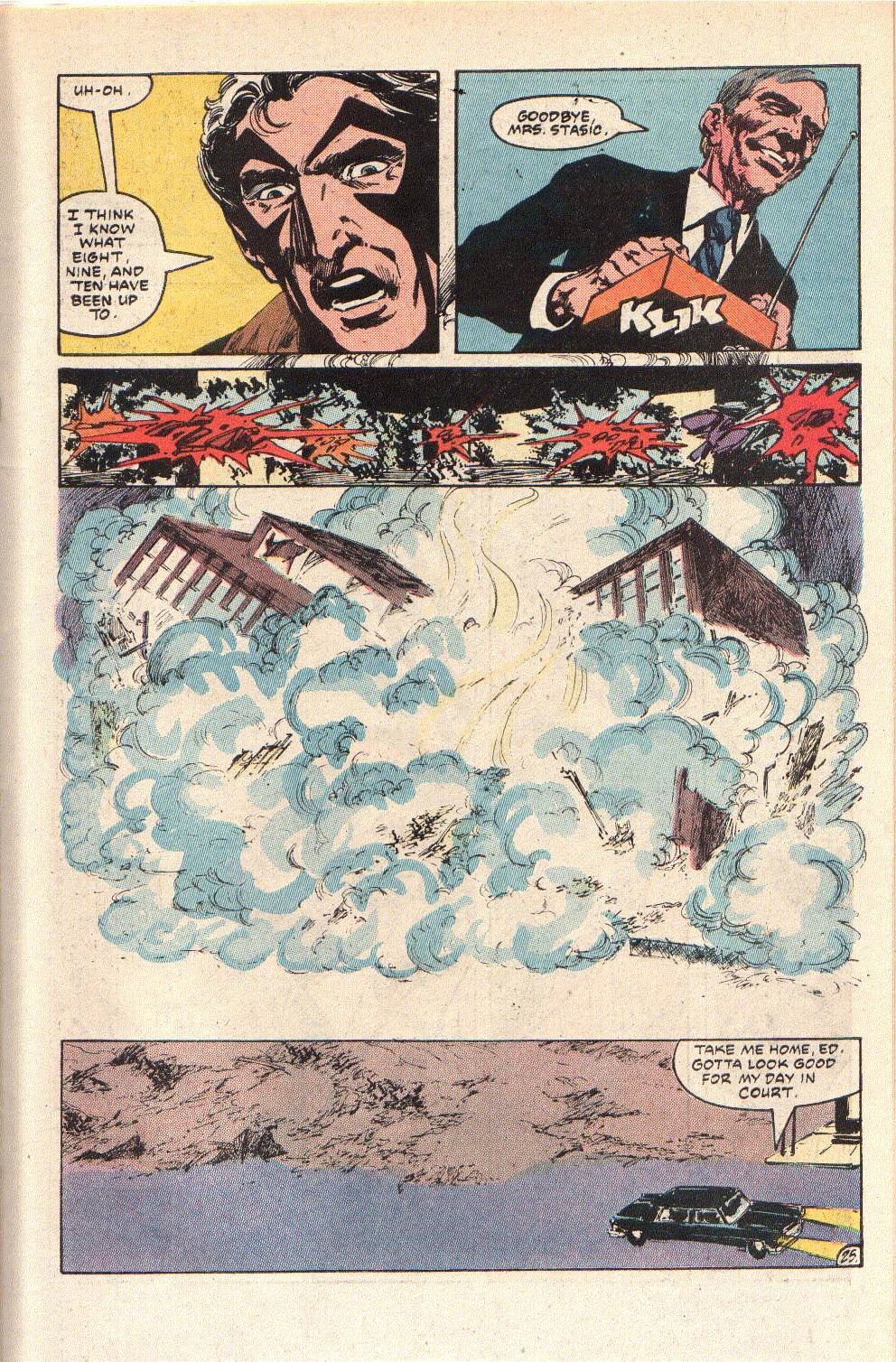 The next morning, Captain Josh Winters, NYPD, is consulting with a patrolman, when they hear a hail. It's Jon and Andrea, in the crane bucket, with Jon telling Winters the lady has a date, in court. Some days later, after testifying, Andrea and Jon relax in his brownstone, when they are interrupted by a different invader.... 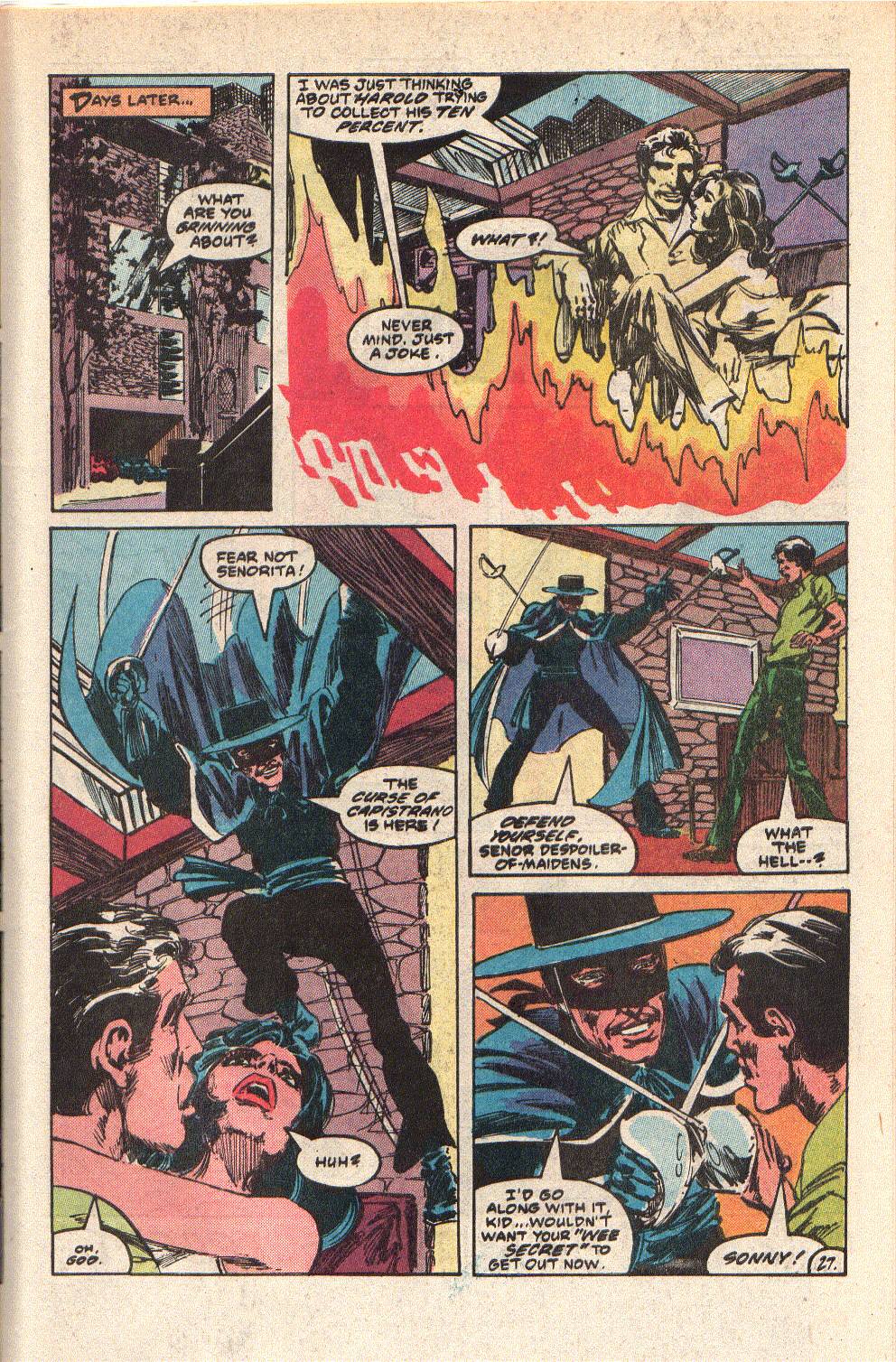 It's Sonny, dressed as Zorro. He tosses Sable a sabre and tells him to fence, unless he wants his "wee secret" to get out. The spar and Sonny outclasses him, disarms Sable, writes his calling card and kisses Andrea's hand adieu and departs. Andrea asks "Who was that masked man?" as Jon stands there, a Z cut into his polo shirt. Thoughts: Exciting issue; pure hardboiled private eye story, with a little added fun, in the form of Sonny Pratt. Typical plot of a detective protecting the star witness to a murder trial, with the accused sending hired killers to prevent them from testifying. Nice bit of cat and mouse, with the under-construction building and the strip club hiding place was a pretty good idea, several years before a similar thing in the film Tango and Cash. The opening wraps up the origin story and pretty much suggests why Eden has never let Jon get any closer than the occasional romp in the hay. He is too dangerous and too damaged and she doesn't want to get to close to that world. Jon kind of trespasses with that world, when he brings Andrea through, in a scene reminiscent of Witness, again, a few years before (and with a stripper, instead of an Amish woman and child). The building set up seems a bit much, like parts of it seem finished, but not others. It's actually not uncommon to leave certain parts of a high rise building unfinished, if they aren't going to be used right away, and concentrate on the parts that will be. This, the penthouse office/apartment is really only missing furniture and decor, while there is plenty of building material to construct the barricades. The one part I call shenanigans is the setting of the demolition charges. That would take hours and it doesn't feel like that much time passes, between Jon's stairwell firefight and the activation of the detonator. It takes a lot to bring down a high rise and you have to rig charges throughout the foundation and support beams to get it to come down, safely. Granted, Baylor wouldn't be as worried about innocent bystanders. Even so, it's a little too "Hollywood." Sonny is one of my favorite supporting characters. He's modelled, a bit, on legendary stuntman Yakima Canutt, who gets name-dropped....  ...with a bit of Douglas Fairbanks thrown in (also name-dropped). Canutt performed the famous runaway stagecoach stunt, in the John Ford movie Stagecoach, as well as in the Republic serial Zorro's Fighting Legion (where he portrayed Zorro, under the mask, while the voice was dubbed by Reed Hadley). The stunt was recreated for the otherwise unimpressive Legend of the Lone ranger and the far more memorable raiders of the Lost Ark, with a truck substituted for the stagecoach. Sonny lets Grell play with old swashbuckler favorites, like Zorro and pirates, while adding some humor to the book, usually at Jon's expense. It ends up being much in the spirit of Inspector Clouseau and Cato, with Sonny usually interrupting Jon, with a lady, with a challenge to a duel, while dressed as a romantic swashbuckling hero. Over time, Sonny transcends the comic-relief role, as his own demons enter Jon's world and take him back to Vietnam, in the two-part "MIA" story, in issues #12 and 13. Nice little single-issue story, after the epic origin tale. We will get back to two-parters, next issue. The letters page includes one from a conservative who is overly enamored of mercenaries (I admit I had a romantic view of them, in 1983; but, I was 16 and had seen The Wild Geese too many times), but the guy definitely reads his own politics into things. Grell actually tends to be pretty middle-of-the-road or apolitical, within the series, depending on the subject. I would say, given Sable's experiences, his political outlook is likely to be cynical and rather different than most people, given how long he lived in Africa, his political experiences there, the '72 massacre, Vietnam, his chosen profession and his other profession. Issue one remarks that he didn't even vote, which suggests to me either he was too busy (fairly likely, in his trade) or viewed both sides with a disinterested eye. I've read Grell's stuff for decades, along with Mike Gold's editorials; I don't think you can lump him into any one camp and any political discussion is likely to be deeper and wider ranging than anything on Fox News or CNN. Ironically, another letter says Jon should be more politicized. It's from a Northwestern student who probably has spent more time in lectures than the real world. I saw a lot of that in my time, as a student. I was too busy with NROTC, a job, and my course work to live in academic abstract. The back page of the book is devoted to an essay by reporter and fan Charles Meyerson, about the "Origins of Independent Comics" 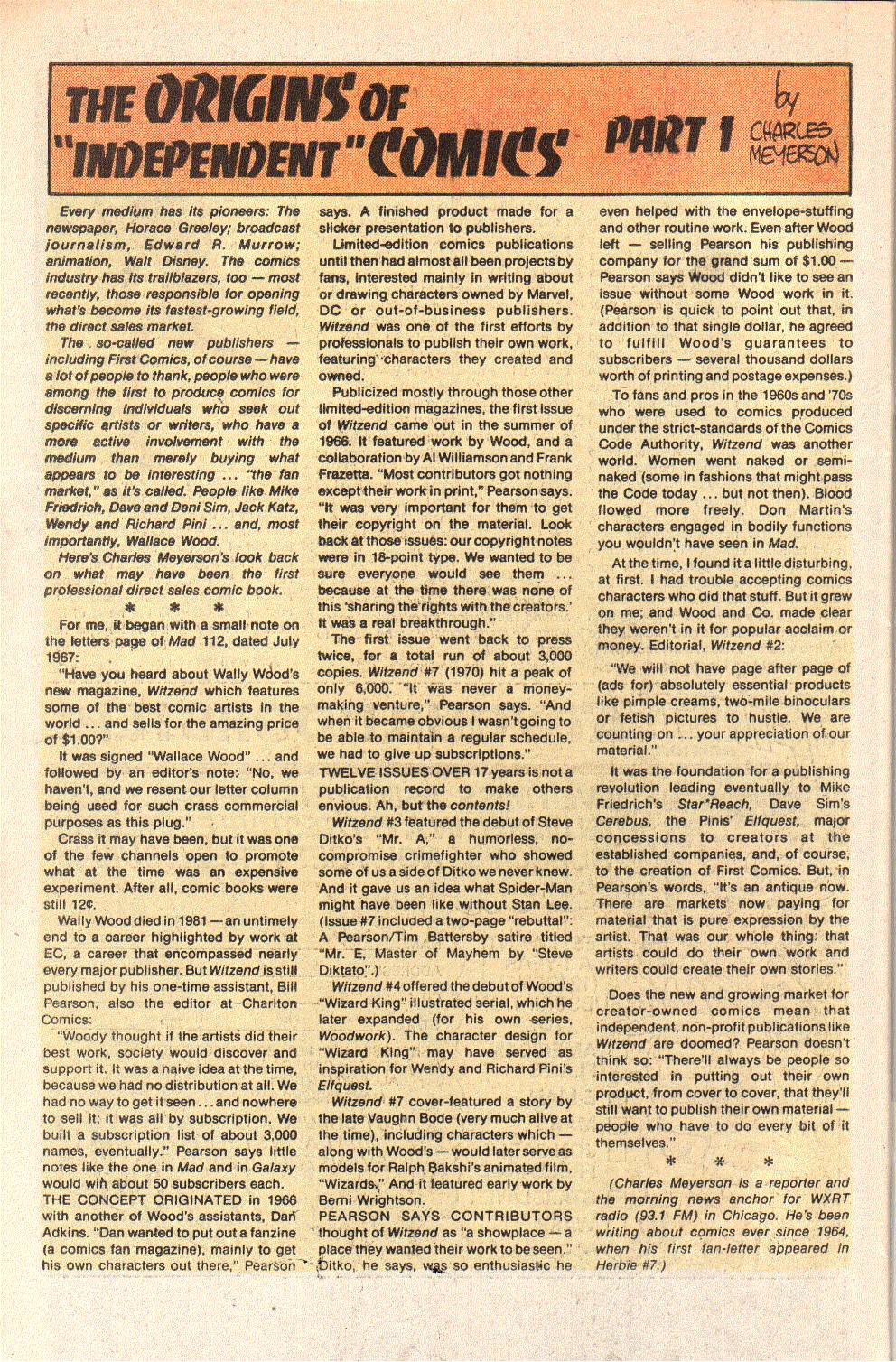 Interesting stuff and you can draw a line from stuff like Witzend and other "pro-zines" and the early self-published material, like the cited First Kingdom, Cerebus and Elfquest (plus the also cited anthologies, like Star*Reach). This is part of what made the indies so great in this period, as we saw experimentation with the medium, a look at the history of the art form, and just plain old personal visions put on display. Some of that would flourish, some of it would whither and die; but, it was an exciting time, while it lasted.
|
|
|
|
Post by earl on Aug 22, 2021 9:14:48 GMT -5
I liked that Grell played off the height joke when Travis Morgan showed up in his Green Arrow run too, playing off that people thought he looked like Ollie, but in the comic Travis much taller if I remember right.
|
|













